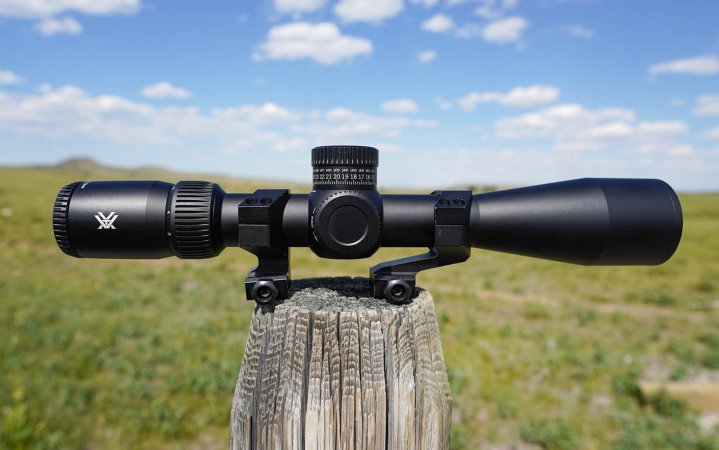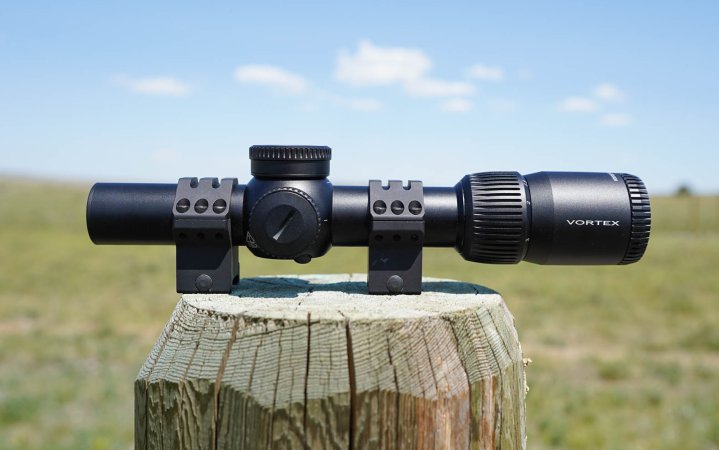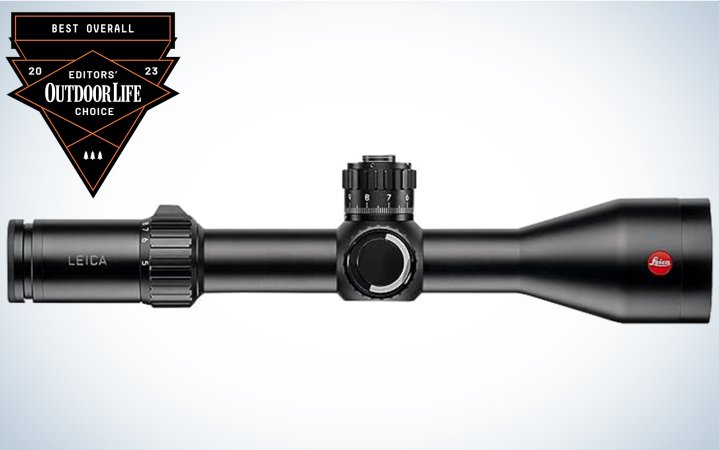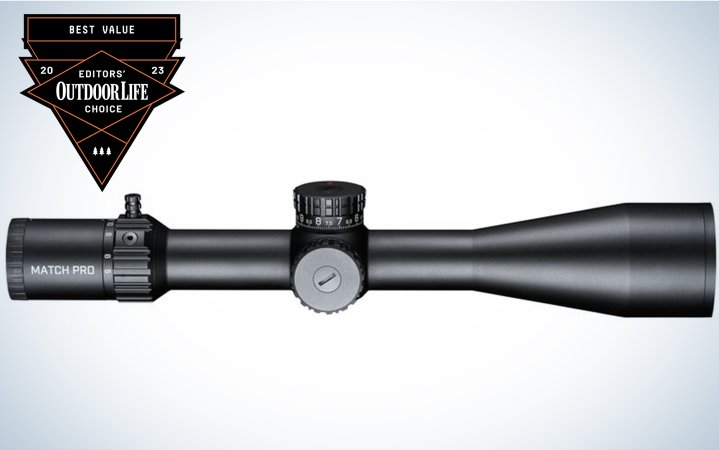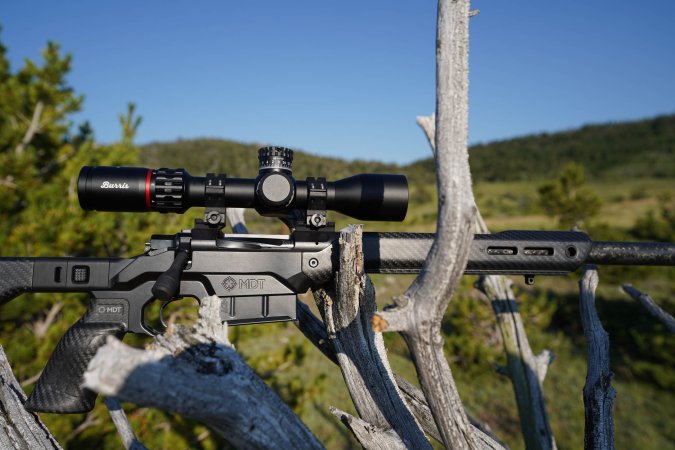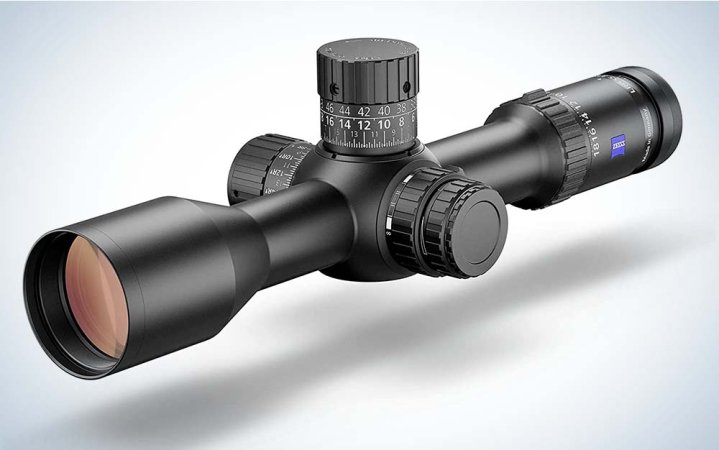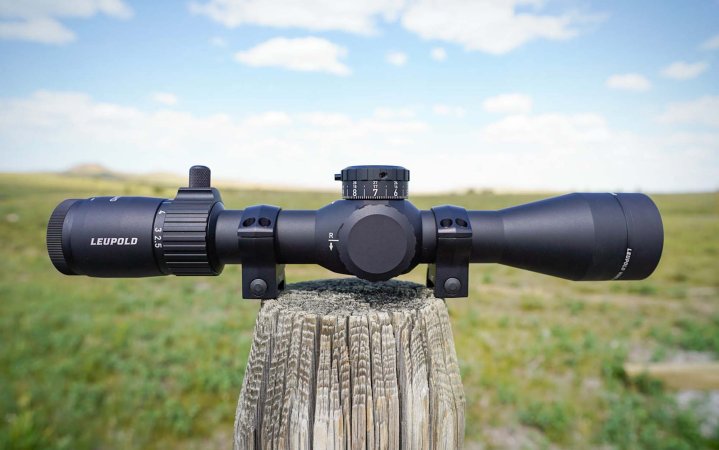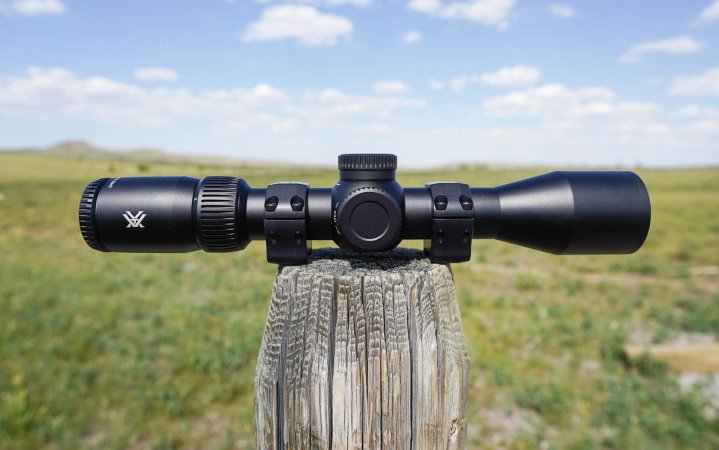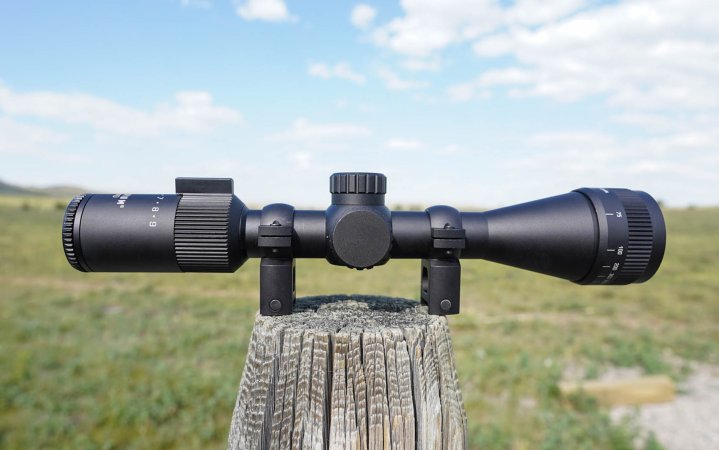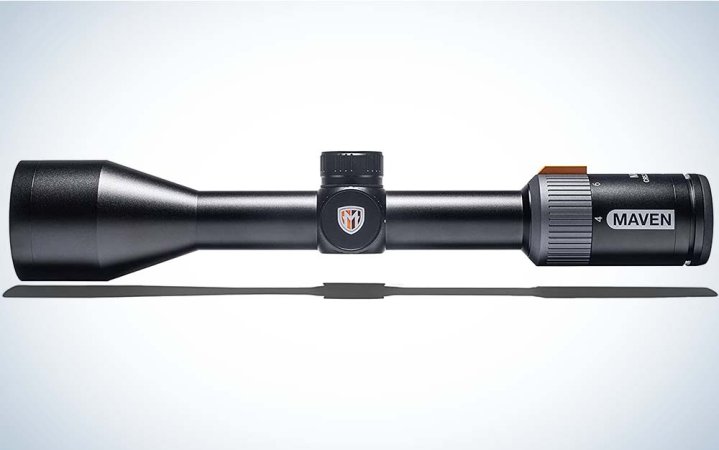We may earn revenue from the products available on this page and participate in affiliate programs. Learn More ›
Rifle scope designs follow trends in the rifles that they’ll be paired with. The 3-9×42 scope, one of the best all-around hunting optics mounted on generations of bolt-action rifles, held sway until rising sales of ARs convinced shooters they needed a short-range optic for home defense. Then long-range precision shooting, and the big chassis rifles that enable those super-long shots, became popular, and the optics industry cranked out big 5-25×56 scopes with supersized turrets and first-plane reticles to serve this new market of shooters.
The new versatile hunting scopes are meant to be paired with lightweight mountain rifles and offer tons of optical horsepower in small packages that are designed to place bullets with great precision — and confidence — when the trophy of a lifetime hovers in the thin air of a distant ridge. I tested a wide range of rifle scopes for their features, optical performance, and turret tracking. When the dust settled, I made my picks for the best rifle scopes for a wide range of uses and host rifles.
- Best Overall: Vortex Viper HD 3-15×44
- Best LPVO: SAI-6 1-6×24
- Best Value LPVO: Vortex Venom 1-6×24
- Best for Long Range Shooting: Leica PRS 5-30x56i
- Best Value Long Range: Bushnell Match Pro ED
- Best Versatile Electronic Scope: Burris Veracity PH 2.5-12×42
- Best Precision Hunting Scope: Zeiss LRP S5 3-18×50
- Best Mid-Range: Leupold Mark 4HD 2.5-10×42
- Best Under $1,000: Zeiss Conquest V4 3-12×44
- Best for Whitetails: Vortex Viper HD 2-10×42
- Best Value: Bushnell R5 4-12×40
- Best Straight-Wall: Hawke Vantage IR Straight-Wall Marksman 3-9×40
- Best Bargain: Monstrum Guardian 3-9×40
- Best Crossover Scope: Vortex Razor HD LHT 4.5-22×50
- Best Compact Rifle Scope: Maven CRS.2 4-16×44
- Best Long-Range Hunting Scope: Tract TORIC UltraHD 2.5-15×44
How We Tested the Best Rifle Scopes
I started by collecting test samples of scopes that are readily available on the market. Some are new for the year, others have been in circulation for several years; note that I did not test every single scope on the market, but rather a representative sample of what’s available. I then measured the optical attributes of each entry, giving each an optical resolution score and testing their low-light performance by viewing a black-and-white resolution target as evening came on my test site in eastern Montana. Unlike the low-light testing that I subject entries in Outdoor Life’s rigorous annual test of new optics, I subjected rifle scopes in this roundup to only one night of testing.
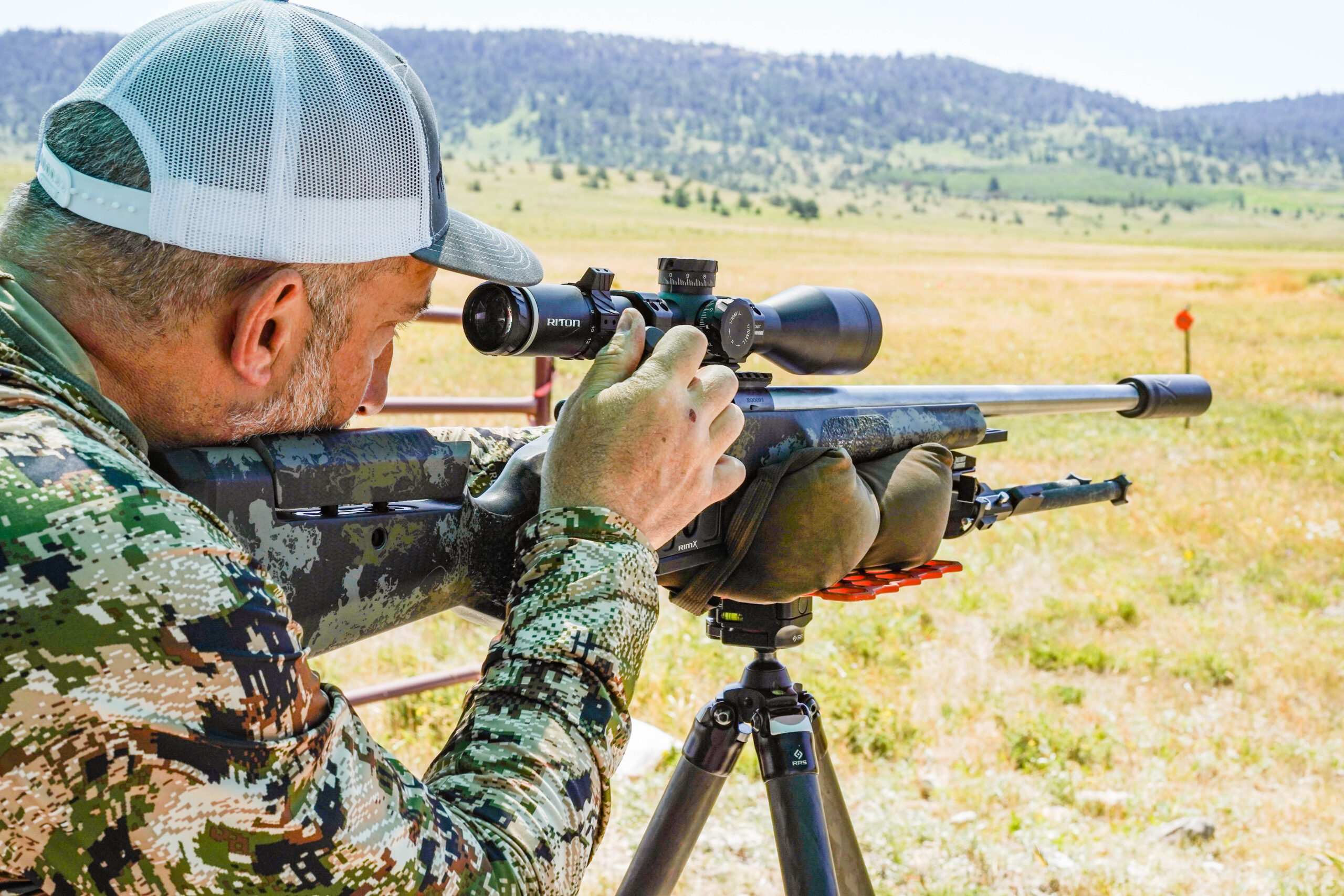
Finally, I strapped all these scopes to rifles and shot them at a battery of targets of various sizes and distances. I use Bergara’s B-14 R, one of the best rimfire rifles, for this portion of the test, because I shoot about 60 rounds per scope, and center-fire rifles tend to beat up the test team. Thanks to my friends at Federal and Remington for supplying match .22 ammo.
The shooting portion tests the ability of each scope’s turrets and reticle to track up and down and then return to zero. I also test the precision of turret and reticle references. The one thing I don’t do is submerge, freeze, and then thaw scopes. I’ve learned through many years of optics testing that only a vanishingly small percentage of scopes will fail this kind of torture testing, and I’d rather spend my time with more meaningful evaluations.
Best Rifle Scopes: Reviews and Recommendations
Best Overall: Vortex Viper HD 3-15×44
Pros
- 5x magnification range
- Versatile hash-based reticle available in MOA or MIL references
- At 11.8 inches and 23 ounces, a very light and compact scope
- Custom turrets available from Vortex
- Ships with sunshade and neoprene cover
- Optional zero stop is nice touch
Cons
- Relatively indistinct turret clicks
- Turret indexing is confusing
- Illuminated dot flares noticeably
Score Card
- Optical Performance: Very good
- Mechanical Performance: Excellent
- Design: Very good
- Price/Value: Very good
Key Features
- 30mm tube
- Second-plane VMR-3 MOA-based reticle
- Pull-to-turn exposed elevation turret, capped windage turret
- Turrets tuned to .25 MOA clicks
- 102 MOA elevation adjustment (47 MOA with RevStop installed)
- 20 yards to infinity side parallax control
- Push-button center-dot illumination
- Price: $1,000
With this center-of-mass scope, Vortex has built an all-arounder that can thrive on any Western hunt, but which can serve capably on a rimfire precision rifle, just about any deer rifle, or even ring distant steel in a pinch. That’s the very definition of versatility.
This is actually a hard balance to strike. Being the opinionated bunch we are, shooters will sniff at an MOA-based scope, but then complain that the MRAD competitor doesn’t have a second-plane reticle. Or a shooter might want a 3-18-power zoom range but prefers an exposed elevation turret. Or they demand a zero stop and a second-plane reticle but will absolutely reject capped turrets. It’s enough to drive a scope designer crazy.
Vortex introduced its new Viper HD line of scopes to the market this summer, with models in the 2-10×42, 3-15×44, and 5-25×50 configurations. The middle sibling reflects the best balance of portability, versatility, and attributes and wins our editor’s choice as the best versatile scope of the year.
Optically, these are fine scopes. While there’s nothing especially wow-worthy about the glass, there’s nothing that will distract from the scope’s job, and we detected no major flaring, edge distortion, or other aberrations. The Viper HD posted top scores in both our resolution and low-light testing.
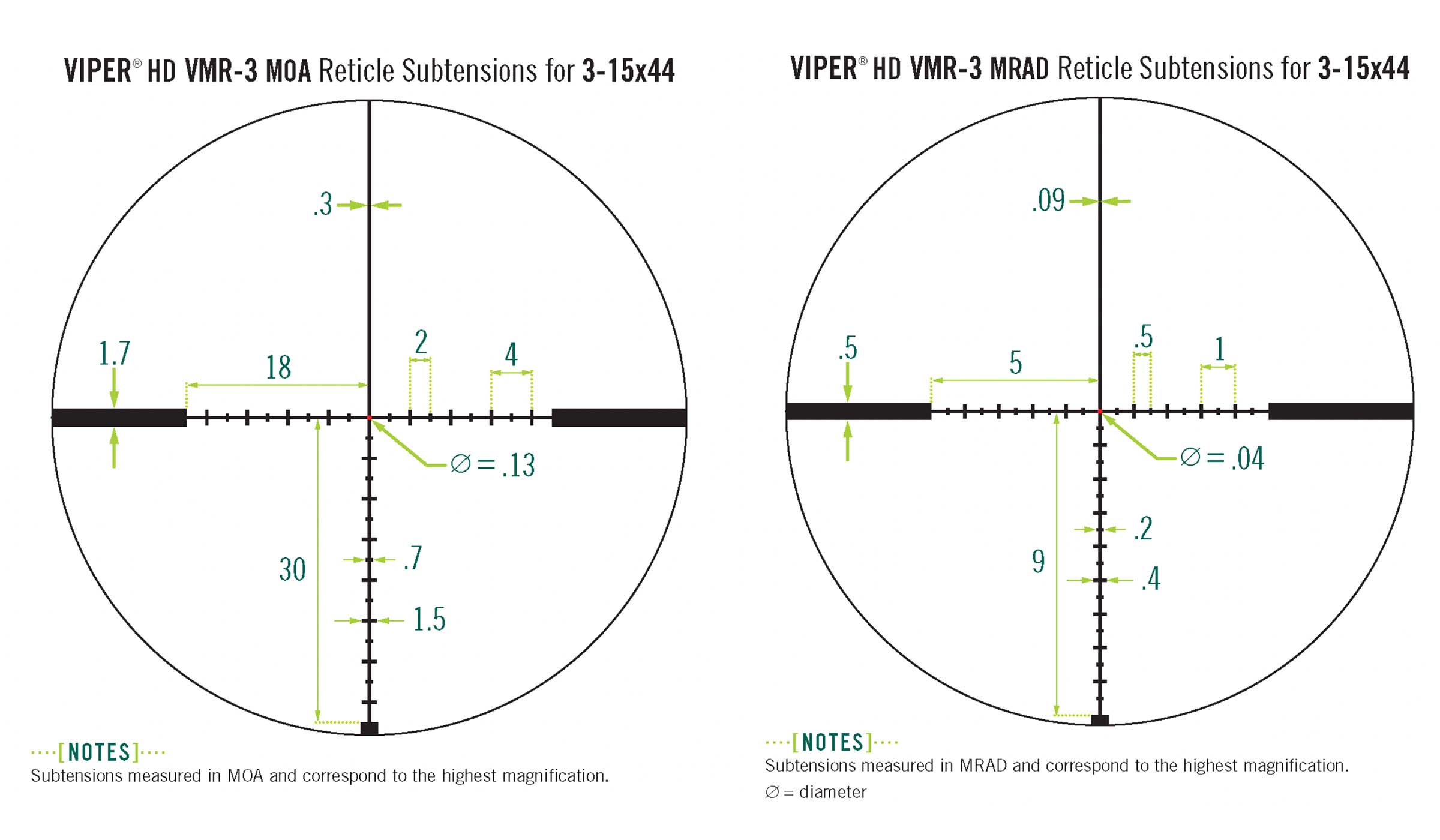
The reticle is a very good balance of speed and precision. While our test scope was delivered in MOA, the Viper HD is also available in an MRAD version, further confirming its versatility. The second-plane reticle is divided in 2 MOA (.5 MRAD) hashes, with 30 MOA (9 MRAD) elevation references and 18 MOA (5 MRAD) windage references on either side of the center cross.
Once you get familiar with the references, the scope delivers a nice balance of speed and precision. We also like the fine (.13 MOA/.04 MRAD) center dot, which is illuminated with a red light, activated by a push-button module and adjustable from a barely visible aiming point for low-light conditions or blazingly bright for daylight shooting.
Other clutch features include a 20-yards-to-infinity parallax control, which makes this a good choice for a precision rimfire rig. Vortex’s excellent RevStop zero stop can be removed or added as needed. The RevStop does substantially limit the elevation adjustment, reducing it from an impressive 102 MOA (30.5 MRAD) down to 47 MOA (18.9 MRAD). But for turret dialers who want a rock-solid stop, the RevStop is simple and effective. And for those who want to dial to the horizon, simply remove the RevStop and keep turning.
Of course, we found some shortcomings. The turret indexing is very busy, with squintingly fine references for two full revolutions. The turret gearing seems a little plasticky, delivering clicks that are a mushy and indistinct. And the center-point illumination is not coherent, meaning that it flares and bleeds into the reticle, especially at full intensity.
On the upside, we got an early version of custom turrets that Vortex has added as a free premium for the 3-15×44 Viper HD. Ours was tuned to the 40-grain .22 CCI bullets we shot, and worked perfectly, giving our testers an extra choice about whether to dial to distance or use reticle references to hold.
We liked the mounting dimensions of the Vortex, and the 44mm objective lens is sized about right for low-profile mounting on a variety of rifle types. At about $850 real-world street price, we realize this is a pricey scope, but it’s right in the middle of the field, and given all the versatility it delivers, we think it’s a good value on an excellent all-around hunting scope.
Read our full review of the Vortex Viper HD line for more info.
Best LPVO: SAI-6 1-6×24
Pros
- At 10 inches and 18 ounces, nicely sized
- Big grippy power-changing dial
- Excellent illumination at all intensities
- Ships with turret cover tethers and flip-up caps
- Reticle subtensions conform to VSOR rangefinder
- Ships with Tenebraex “killFlash” anti-reflection device
Cons
- Turret controls are tiny and hard to turn
- Some fishbowl aberration at 1-power
Score Card
- Optical Performance: Very Good
- Mechanical Performance: Excellent
- Design: Very Good
- Price/Value: Good
Key Features
- 30mm tube
- First-plane RAF (Rapid Aiming Feature) reticle
- 9-step red center-cross illumination
- Capped turrets tuned to .1 MRAD click values
- 35 MRAD total adjustment range
- Parallax fixed at 110 meters
- Weight: 18 ounces
- Price: $1,492
This LPVO is a complete package. While it’s intended as an AR scope — the ranging references in the lower left image plane are tuned to the dimensions of an IPSC target — we would gladly mount this on a turkey or slug gun. And its fast target-acquisition talents and expedition-grade build made it the runaway choice of testers for a dangerous-game rifle optic.
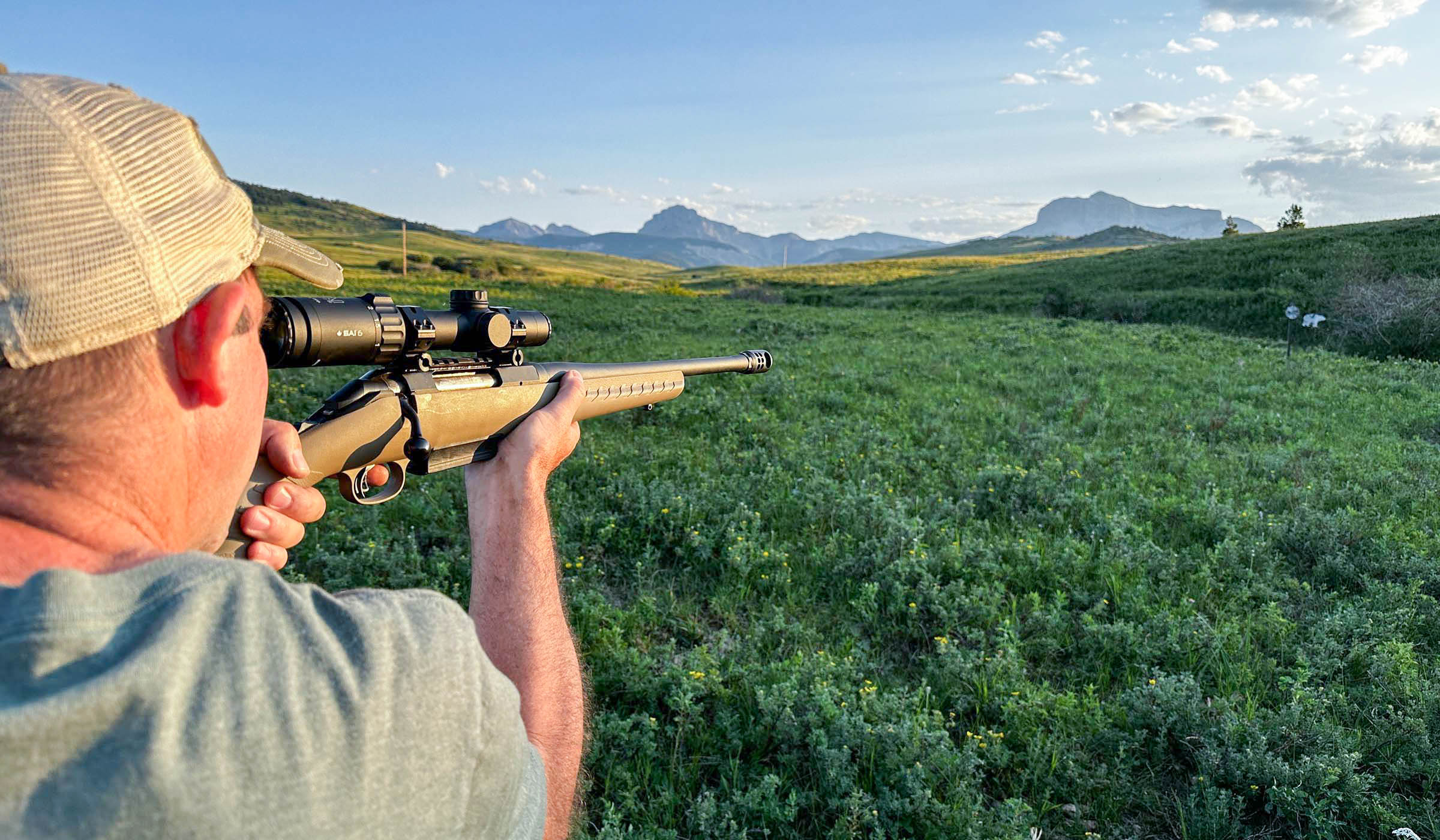
SAI is the optics branch of Armament Technology, the Canadian company that specializes in combat sights. The company’s martial DNA is all over this scope, from its rubberized turret-cap tethers to its aggressive first-plane Rapid Aiming Feature reticle.
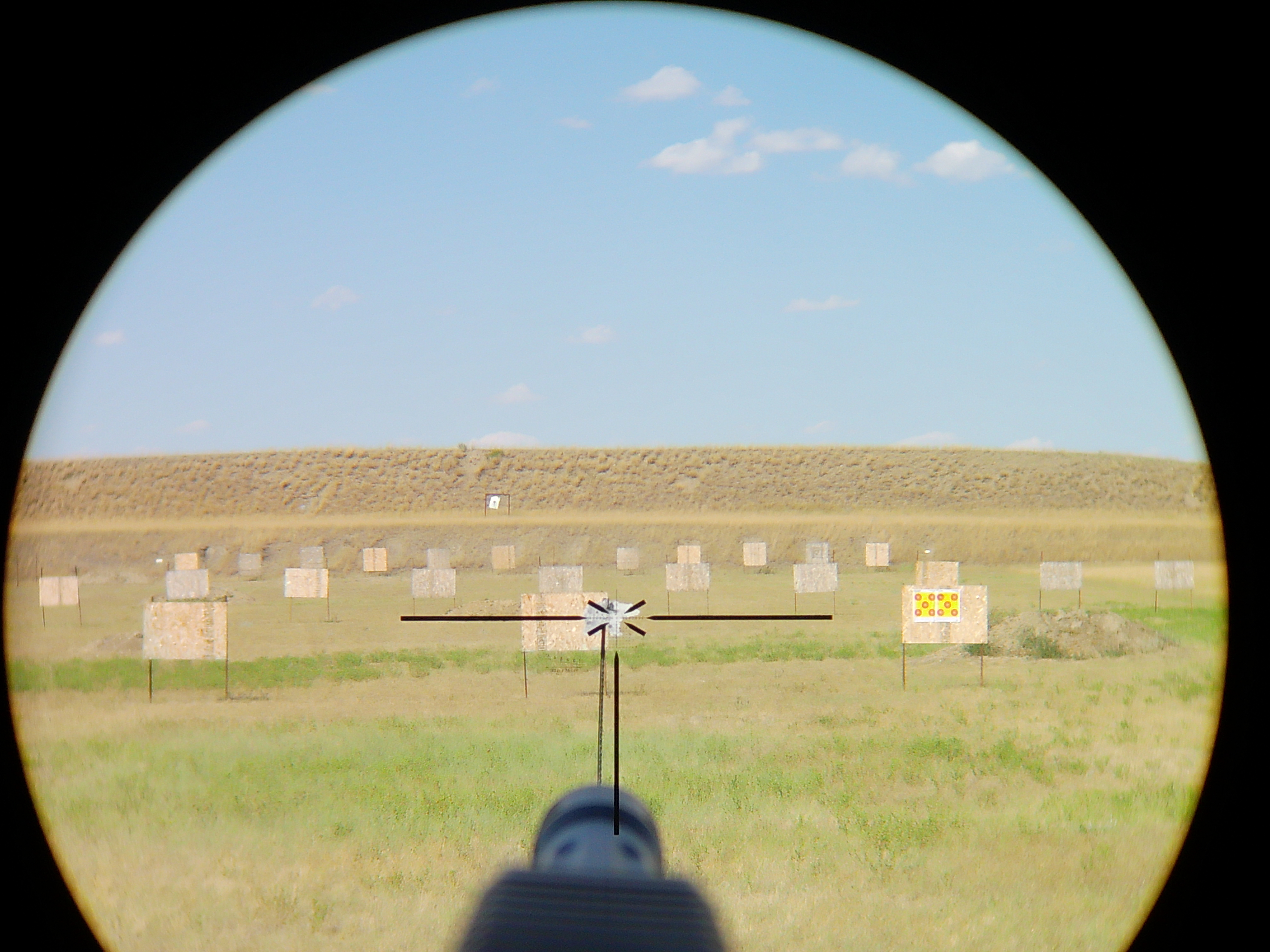
The reticle deserves its own paragraph. Tester Josh Ward said the 5.56 BDC reminded him of “the plasma rifle reticle from Halo” video games, and Scott Einsmann thought it could have been designed by his 4th grade self. The four super-bold extended triangles that all point to the center aiming cross “look hokey and like a marketing team designed it to look cool,” said Einsmann. “But holy cow, does it work. It sucks your eye to where you want bullets to go at 1X, even at 100 yards.”
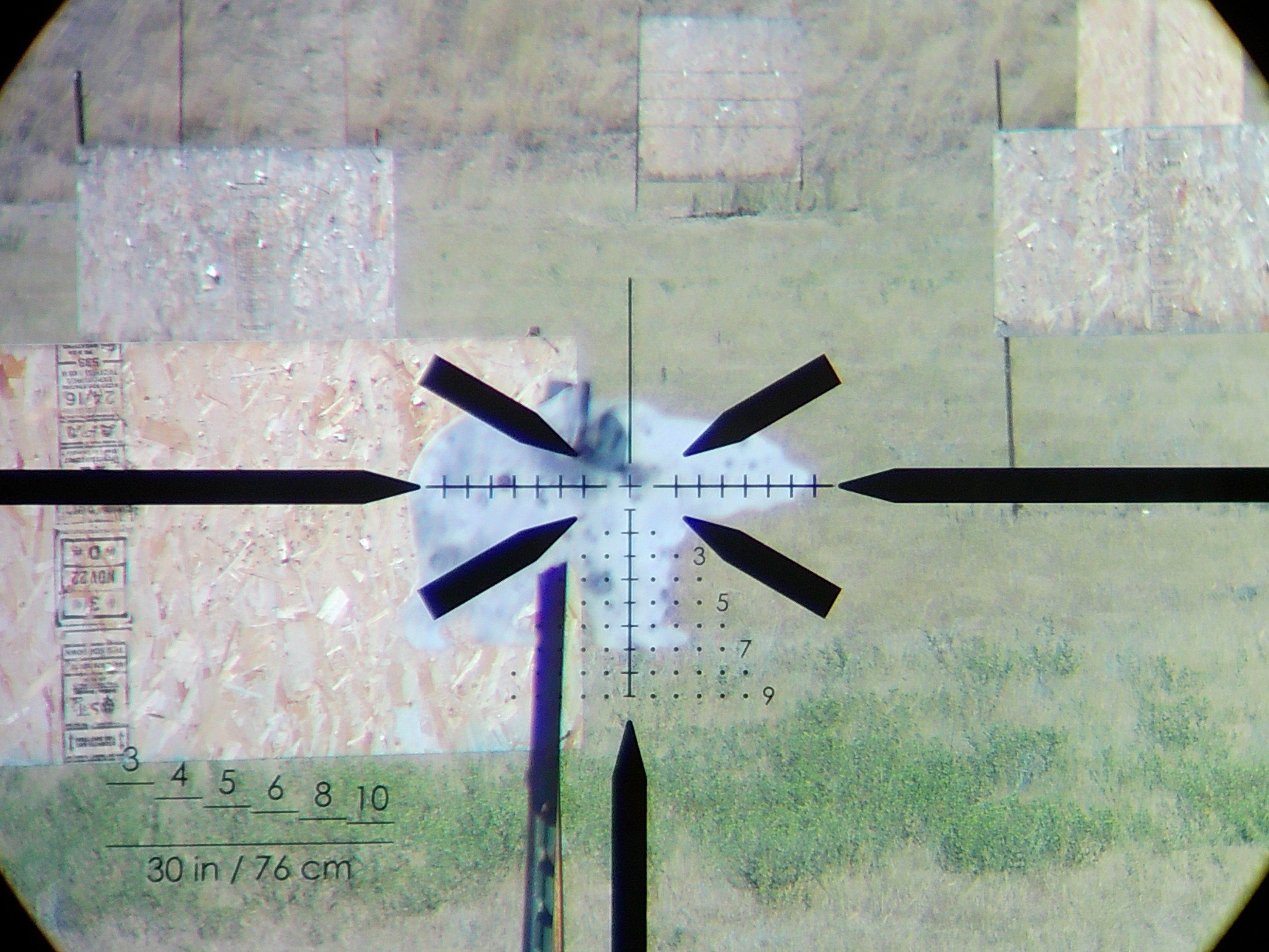
We strapped the SAI-6 to a 450 Bushmaster bolt gun and put the scope through a dangerous-game simulation, walking up on a (steel-plate) grizzly bear through obscuring brush. When the shooter’s companion yelled, the shooter had to acquire the target and make a snap shot under simulated duress. Nearly every first- and second-round shot in this little game rang steel in less than 2 seconds behind the SAI-6.
The ranging grid in a corner of the RAF reticle is designed to be used in tandem with Armament Technology’s Vertical Subtension Optical Rangefinder system. Distance to a known 30-inch tall target (human torso) can be determined by bracketing the target in the rangefinder. We found the system to work well with steel targets of known dimensions, and it would work just as well with the spine-to-belly dimensions of a large deer or an elk.
The reticle’s illumination, blazing from daylight bright to barely visible for nighttime operations, is one of the best in the test, with intensity controls that are positive and levels separated by off positions.
We gave the scope some demerits. The turret controls are tiny and maddeningly hard to turn. We’d like a throw lever to enable even faster magnification changes. At just under $1,500, this is a pricey scope, though we reckoned that the SAI brings just as much or even more to the party than the other three LPVO scopes in our test priced at a similarly aspirational level.
For its bombproof build, its responsive controls, and its excellent glass, but especially for its extremely useful reticle, we gave the SAI-6 our Editor’s Choice award for the top LPVO in the field.
Best Value LPVO: Vortex Venom 1-6×24
Pros
- Reticle configured for AR platforms
- Ships with flip-up lens caps and throw lever
- 10.3 inches and 19.5 ounces
- Reticle tuned to ballistics of 5.56 loads
- At about $300 real-world price, a screaming deal
Cons
- At low magnifications, image fishbowls
- Reticle a little small for longer-range precision
Score Card
- Optical Performance: Good
- Mechanical Performance: Excellent
- Design: Very Good
- Price/Value: Excellent
Key Features
- 30mm tube
- Second-plane AR-BDC3 reticle
- Capped turrets tuned to .25 MOA click values
- 140 MOA total internal adjustment
- Parallax fixed at 100 yards
- 6-step red illumination
- Weight: 19.5 ounces
- Price: $300
You could subtract points from this scope for its very narrow utility. Its AR-BDC3 reticle in the second plane is tuned to the ballistics of standard loads from a 5.56 with velocities from AR carbines. With that use-case in mind, and with a 100-yard zero, the reticle’s holdover references should drop a 55-grain bullet into your target out to 650 yards.
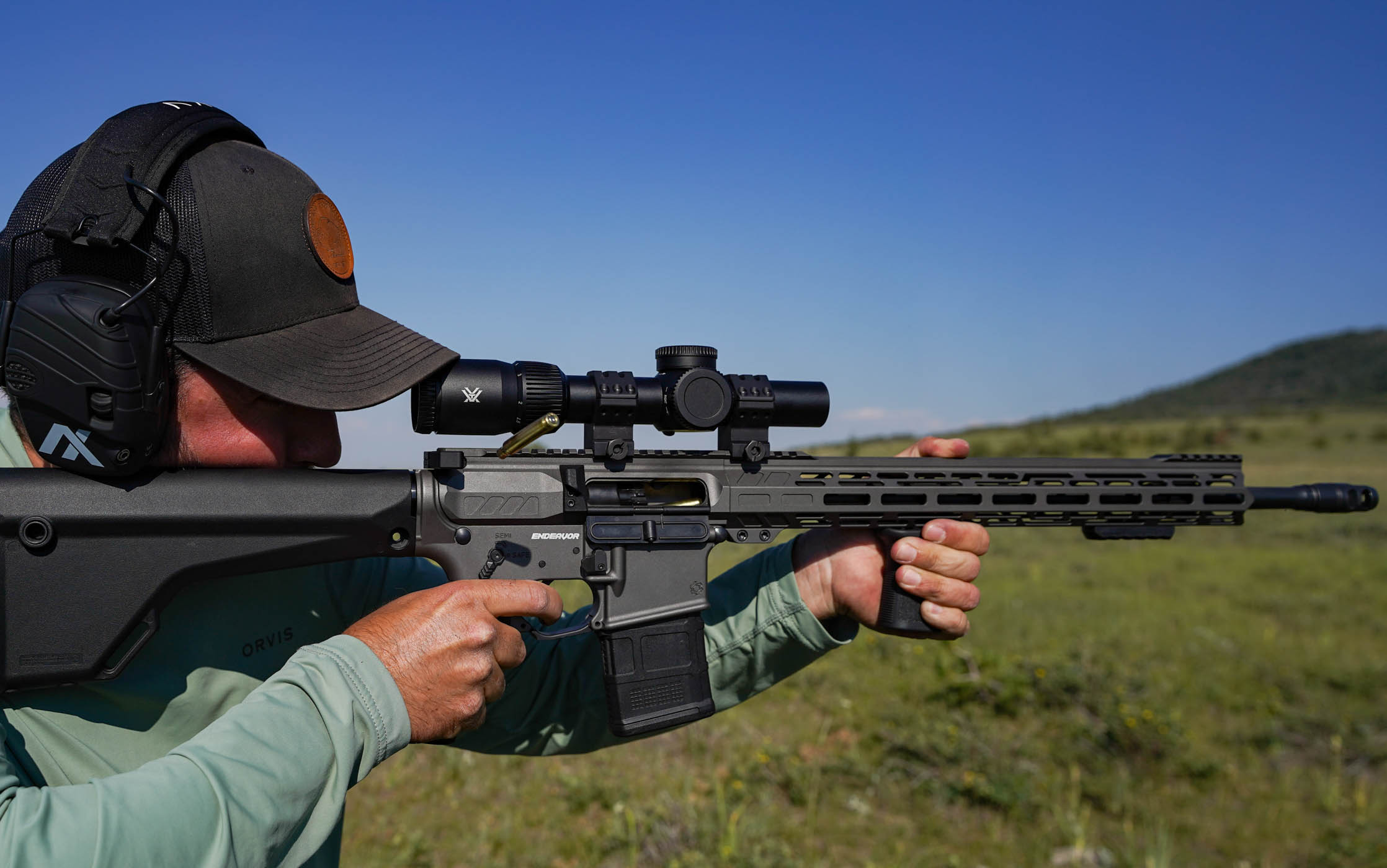
While the Viper was one of the best AR-specific LPVOs in our test, it would be a mistake to limit your consideration to AR-15s. The scope is a wonderful rimfire optic, and we found it to be fast and reliable for dangerous-game hunting. While we might not put it on a hard-bucking turkey shotgun, it’s suitable for straight-wall cartridge rifles.
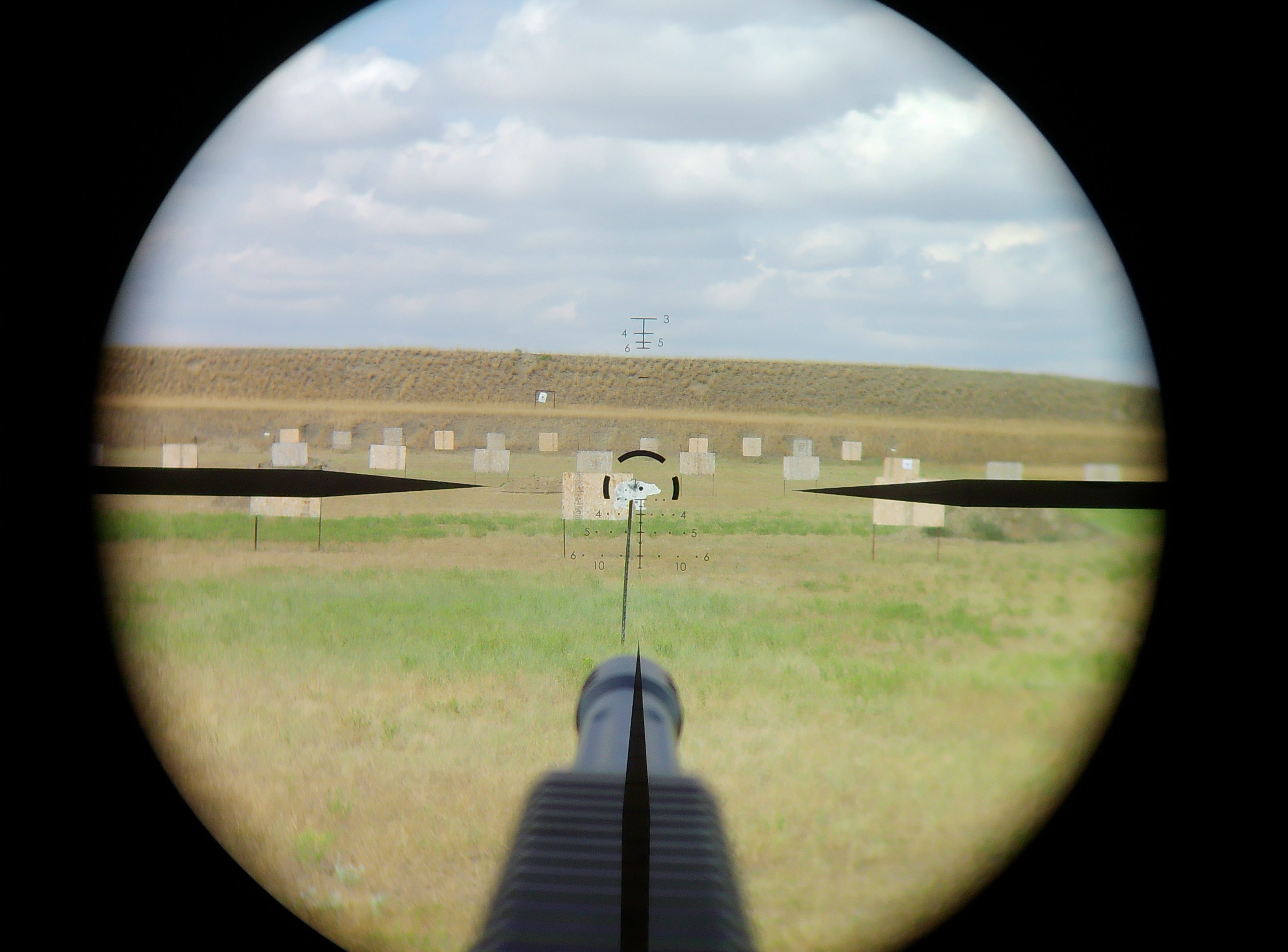
The heart of the scope is an MOA-based segmented circle. The 16-MOA circle halfway surrounds a floating 1-MOA illuminated dot. Non-illuminated hashes provide holdovers at 200, 400, 500, and 600 yards with a 100-yard zero and windage dots represent holds for standard-value right-angle winds. Note that the subtensions work only at the scope’s highest power.
The scope’s controls received mixed reviews, as you might expect in a price-point optic. Most testers recorded indistinct turret clicks and noted the illumination is useful only at the highest and lowest intensities. We also noted significant distortion at 1X, with convex “fishbowling” curving the image when we panned across the landscape. Do it quickly, and you can feel almost seasick.
But the Vortex has so much value, and brings attributes to the game that many of its peers couldn’t bring at twice the price, that it is the consensus pick for our Great Buy award as the screaming deal of this year’s LPVOs.
Best for Long Range Shooting: Leica PRS 5-30x56i
Pros
- Extremely bright and clear glass
- Velvety controls
- PRS reticle is simple and versatile
- At 14 inches, fairly compact
- Elegant proportions and design
Cons
- Reticle offered only in MIL, not MOA
- Less internal adjustment than peers
- At about $2,900, spendy price
Score Card
- Optical Performance: Very Good
- Aiming System: Excellent
- Design: Excellent
- Price/Value: Good
Key Features
- 5-30-power magnification
- 34mm tube
- 32 MRAD elevation, 18 MRAD windage adjustment
- First-plane MIL-based PRS illuminated reticle
- Tool-less turret removal
- Zero-stop tools stow under turret cap
- 22 yards to infinity parallax correction
The performance of the Leica PRS scope, when stacked up against some excellent newcomers, frankly surprised the test team. We’ve been admirers of the European precision scope since Leica introduced the PRS in 2020, but we didn’t expect it to stand up to competition from Vortex, Steiner, Nightforce, or Zeiss, brands that have all brought new and very capable precision scopes to market in the three years since Leica unveiled its PRS.
We’re happy to report that the Leica not only thwarted its dethroners, but it did it with both style and elegant precision.
The Leica precision scope is defined, like so many of its other optics, by beautiful, luxuriant design and responsive mechanics. “Everything on this scope speaks to its quality,” noted tester John B. Snow, OL’s shooting editor. “Tight, smooth controls. Great tactile feedback. Lovely fine aiming points on the reticle.”
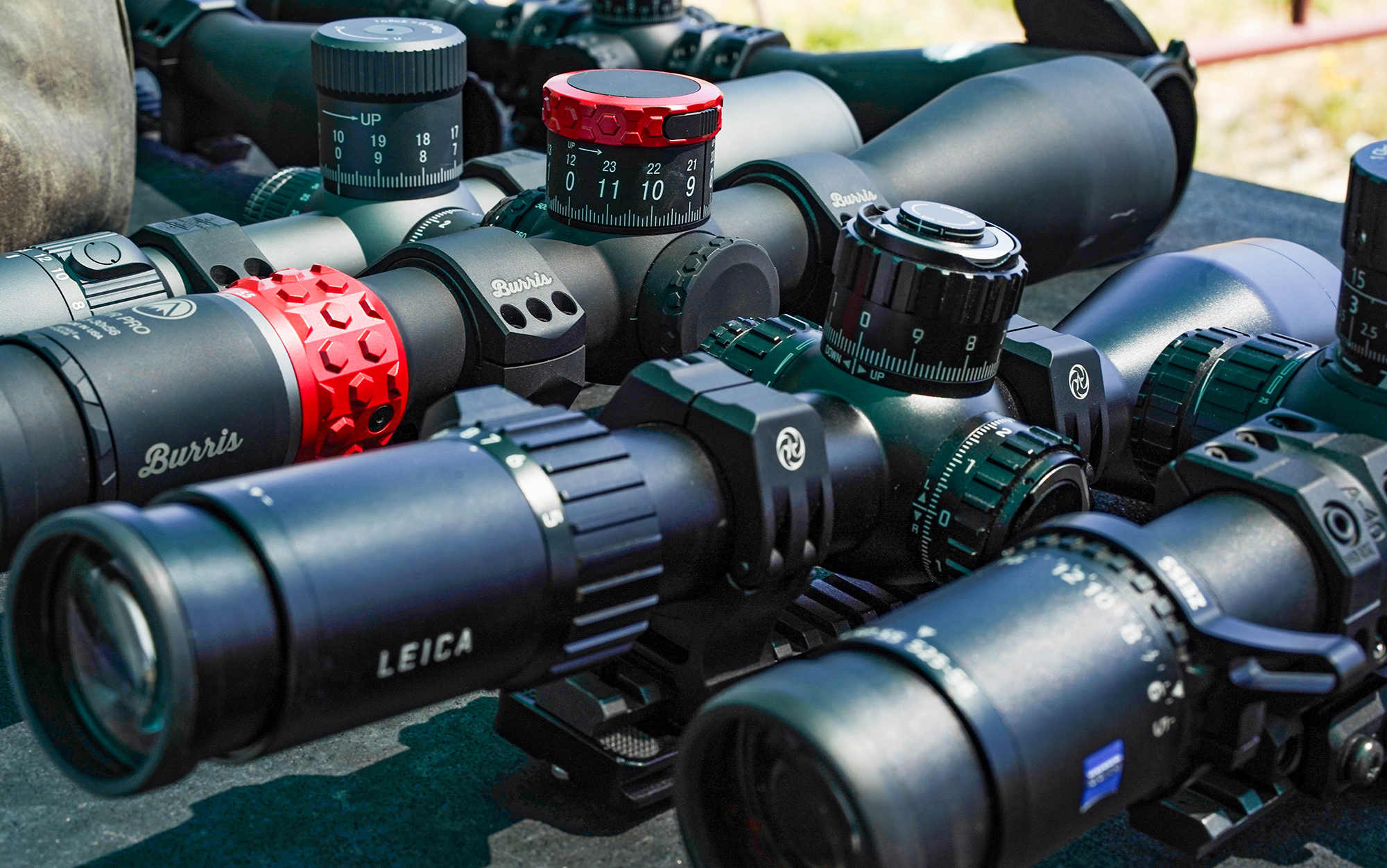
The enduring success of the Leica PRS speaks to the quality of its components. The world-class glass is crisp and clear, which amplifies the reticle detail. The turrets are positive and tight, evidence of precise machining. And the design is timeless, which might be expected of a global company that has to appeal to European hunters and American competitive shooters.
But design and luminous glass don’t win long-range shooting competitions. Absolute precision and agreement between turret and reticle do, and Leica’s mechanical performance has allowed it to stand the test of time. Controls turn with tight, smooth precision, and the tactile feedback from its turrets is the best in the class. The PRS reticle is built around an open .1 MIL dot with .2 MIL steps in a Horus-style grid. It’s a fast, simple, versatile reticle that isn’t intended to be flashy or innovative but rather quietly precise. It must be noted that the windage dots are too faint for some shooters using the scope under 10-power magnification, and the reticle could use weighted visual references for even faster deployment.
The tool-less elevation turret is a thing of mechanical beauty and simplicity, and the compact design is a nice change from a trend toward gargantuan precision scopes. The mounting dimensions on the 34mm tube are a little stingy, but we haven’t found an action or receiver rail it doesn’t fit.
The Leica’s elegant lines and royal bearing might deceive some shooters that it’s simply easy on the eyes. But the PRS is among the most precise and responsive optics we’ve ever tested.
Best Value Long Range: Bushnell Match Pro ED
Pros
- At around $650, excellent price
- Ships with throw lever and sunshade
- Turrets are easy to rezero
- Clear and useful turret indexing
- Simple and durable zero stop
Cons
- Turret clicks are mushier than peers
- Image is dark
Score Card
- Optical Performance: Good
- Aiming System: Very Good
- Design: Fair
- Price/Value: Excellent
Key Features
- Pull-to-turn turrets
- ED glass in objective lens
- Turret revolution indicator
- 34mm tube
- First-plane DM2 reticle
- 11-step illumination
- 15 yards to infinity parallax adjustment
- 30 MRAD elevation, 14.5 MRAD windage adjustment
This is one hell of a scope for the money. Actually, it’s a hell of a scope for twice the price. Bushnell’s reinvented Match Pro brings a very useful and versatile reticle for just about any type of target competition, very good controls, and honest performance. Our test is designed to find shortcomings in just about any submission, but try as we might to detect where Bushnell cut corners to arrive at an under-$700 precision scope, we couldn’t find fatal flaws.
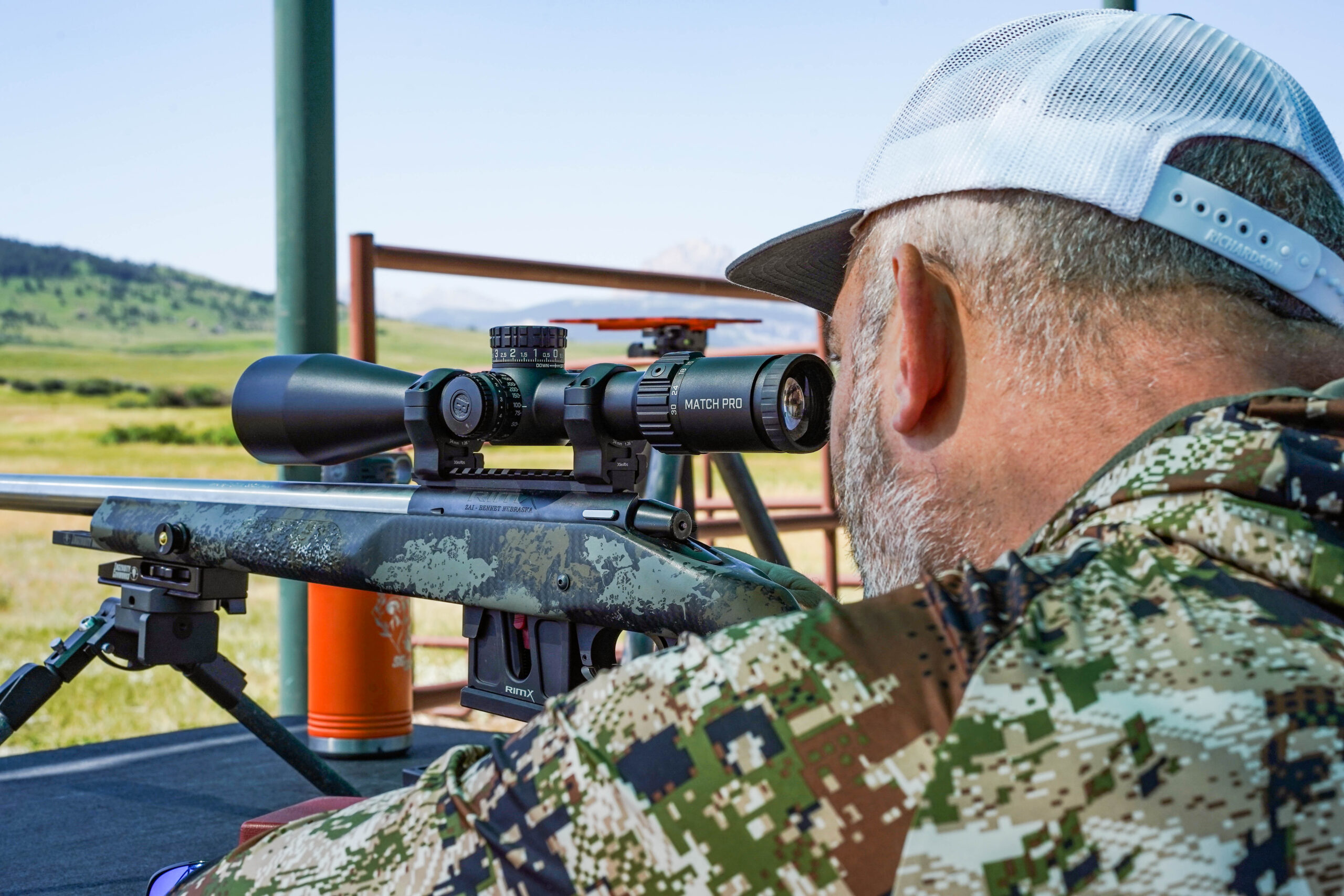
That’s not to say this scope is on par with the $3,000 submissions in the field. The optics are forgettable, despite extra-low-dispersion glass in the objective lens. And turret components are similarly pedestrian; we noted some mushy response in our dialing regimen.
But here’s what you get for your money, and why we tapped the Match Pro ED as our Great Buy in the precision riflescope field. You get low-profile, beautifully indexed turrets with a smart red button that pops up on the second revolution, a very serviceable reticle, and a range of adjustment that can win rimfire competitions and should show up on PRS and NRL long-range steel competitions over the next few years.
“I’d recommend this scope for any shooter on a budget,” said one tester, who amended his comment. “Actually, I’d recommend this scope for a shooter on any budget.”
The DM2 reticle, which stands for Deploy Mil 2, was one of the most visible precision reticles in our low-light test, which measures how long shooters can see a non-illuminated reticle in the dark in order to make a reasonably certain shot. Its weight is balanced between visibility and non-obscuring of the target, and it makes good use of nomenclature, with even-numbered holds in a large font and odd-numbered holds in a smaller font. In all, it’s a fast, serviceable reticle.
Add Bushnell’s excellent warranty to the mix, and you get a very useful precision scope for a fair price, and should be considered by any shooter looking to get into long-range and rimfire competitions.
Best Versatile Electronic Scope: Burris Veracity PH 2.5-12×42
Pros
- Extremely programmable and customizable
- Pairs with BurrisConnect mobile app
- Clickless elevation turret allows for fine tuning hold
- Excellent glass
- Useful even if battery dies
Cons
- Relatively tedious set-up
- Glass caused eye fatigue in some testers
- Function dial is easy to confuse with parallax knob
Score Card
- Optical Performance: Very good
- Mechanical Performance: Very good
- Design: Very good
- Price/Value: Good
Key Features
- 30mm tube
- First-plane 3PW Wind MOA reticle
- Digital heads-up display indicates elevation hold
- Clickless programmable elevation turret tuned to .25 MOA clicks
- Re-zeroable turrets
- 25 yards to infinity side parallax control
- Red center-cross illumination
We struggled a bit with the first iteration of the Veracity PH, which was in last year’s test. The interface with the mobile app was glitchy, and the inputs didn’t seem to guide bullets precisely past about 300 yards. With this second generation of the smart scope Burris has simplified the interface, and we found it to be responsive, precise, and really fun to shoot once we had all the inputs in place.
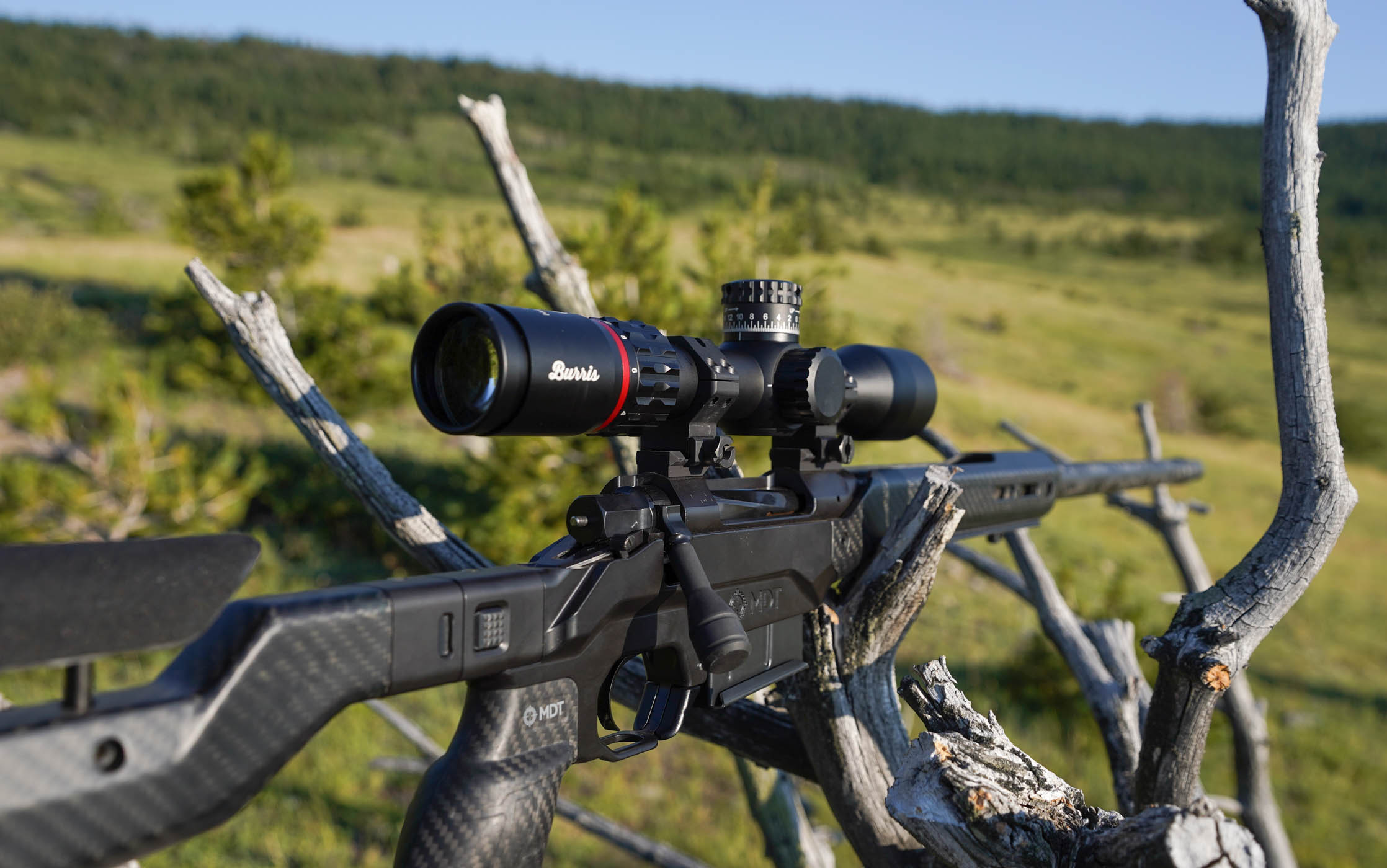
Like many ballistics solvers, you get out of the Veracity PH what you put in, meaning that you must have precise muzzle velocity, ballistic coefficient, and other inputs loaded into the Burris app in order to get the scope to guide a bullet’s parabola properly. But when you do, shooting precisely is a matter of porting the customized ballistics into the rifle, ranging your target, dialing the elevation knob to the appropriate yardage, holding where it tells you to, reading the wind, and delivering the bullet. We shot the Veracity PH on a wide range of rifles, including a 6.5 PRC chassis rifle, a 6.8 Western bolt gun, and a whole rack of .22 precision rifles, and found the system worked well across platforms.
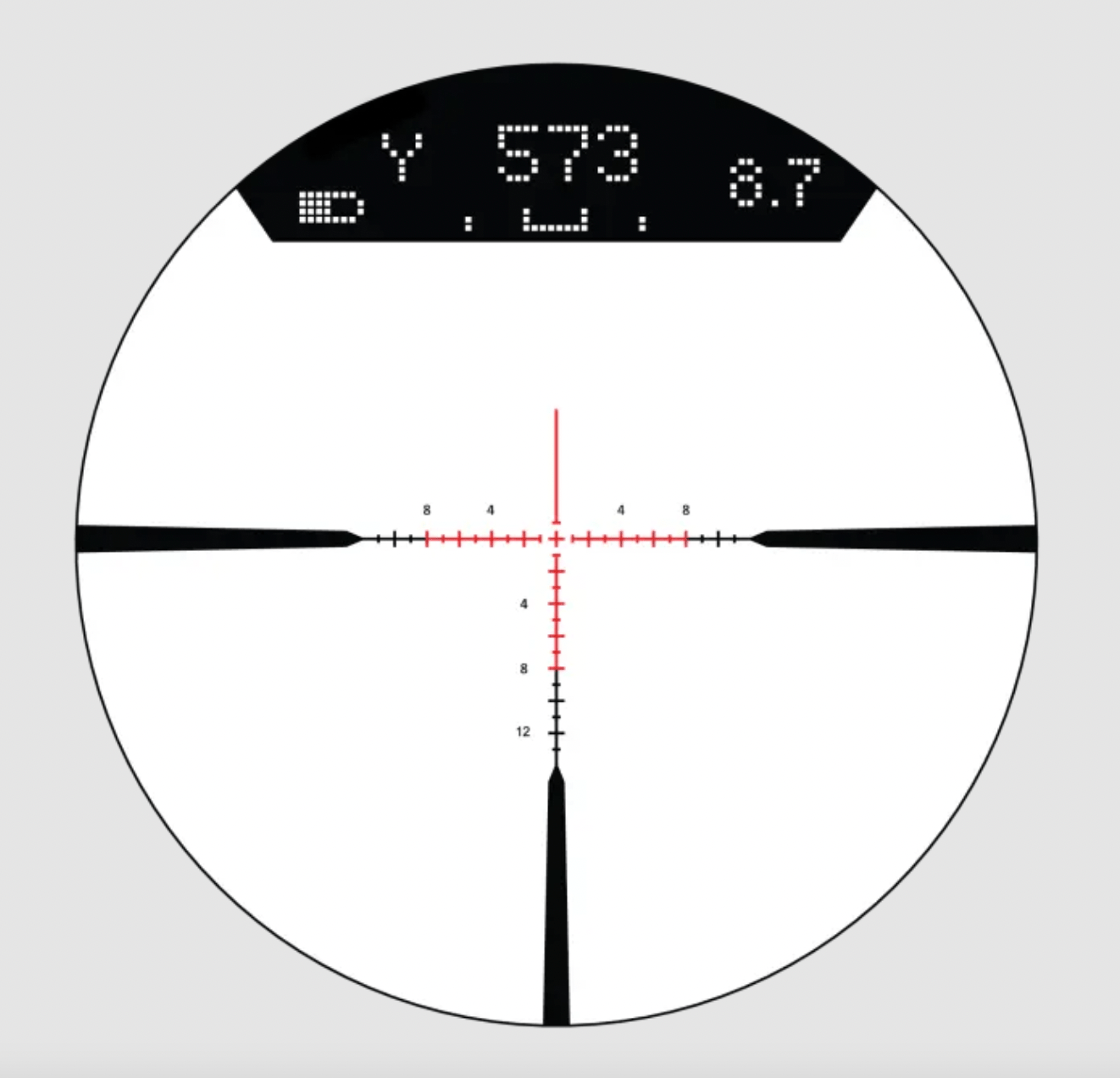
The electronic brains of the Veracity PH are the headliners of the scope, to the degree that it’s easy to forget its more pedestrian features. But the Burris has good glass, though it’s a little undercoated for our liking. The aggressively textured controls turn with precision. The reticle, with 12 MOA of windage holds on either side of the illuminated center cross, is useful, and we like the tapered posts for centering our eye on the target.
The main design flaw we noted is that the two left-side controls — the inside knob for parallax and the outside control for powering up the heads-up display, connecting to Bluetooth, and controlling illumination — are easy to mix up while a shooter is behind the scope. While trying to focus our target, we’d often turn off the unit, requiring a pause in shooting while we reconnected to the app.
But that’s one of the very few demerits we gave the Burris. At a little over $1,300, it’s pricey, but entirely in line with its abundant attributes.
The overall handling of the scope is good enough that the test team had a vigorous debate about whether the Veracity PH should win the category as the most versatile scope in this year’s field. Ultimately, its few demerits kept it from the top spot, but its wide utility, increased user-friendliness, and bullet-placing talents make the Veracity PH one of the most versatile scopes we’ve ever tested.
Best Precision Hunting Scope: Zeiss LRP S5 3-18×50
Pros
- Extremely bright and high-contrast glass and coatings
- First-plane turret available in MOA or MRAD values
- Precise, positive turrets
- Internal adjustment range enables shots from 100 to 1,500 yards
Cons
- At over $3,000, this is a pricey scope
- The illumination module on my sample didn’t work
Key Features
- Magnification: 3.6 to 18 power
- Field of view at 100 yards: 30 to 6 feet
- Adjustments: .1 MRAD or .25 MOA
- Weight: 32.8 ounces
- 34mm tube
- Massive amount of internal adjustment
- Extremely tactile turrets
- Precise first-plane reticle
A serious precision hunting scope from one of the members of European optical royalty, Zeiss’s LRP S5 combines the best attributes of long-range precision shooting with a smaller, more versatile configuration. At 2 pounds, this is still a whale of a scope, but its relatively short (13-inch) length and 50mm profile allow for versatile mounting options.
The guts of the scope—my test sample had the ZF-MOAi Reticle 17 tuned to MOA references—is smart and useful. From 3.6 to about 10-power the first plane reticle features a fast, intuitive German 1 bold duplex, but from 10- to 18-power, the precision references come into view, offering 40 MOA of holdover and hold-off windage references with 1 MOA hashes. The scope is also offered in an MRAD version that has a modified Christmas tree design with holds represented in 0.2, 0.5, and 1.0 MRAD increments. Both versions are designed to enable shooters to dial holds from 100 to 1500 yards without using the reticle’s holdover references.
This is a big, serious, purpose-built rifle scope that was years in the making. Zeiss has a winner on its hand, though unfortunately, there’s a small subset of hunters who will use the LRP S5.
Read our full long range rifle scopes test for more options.
Read Next: Best Rimfire Scopes
Best Mid-Range: Leupold Mark 4HD 2.5-10×42
Pros
- 4x magnification range
- Versatile hunting reticle with elevation and wind holds
- At 12.5 inches and 21 ounces, a very light and compact scope
- Excellent turret indexing
- Smooth and precise controls
- Push-button illumination has auto-shutoff
Cons
- Without manual parallax setting, some focus issues
- Reticle illumination could be brighter
Score Card
- Optical Performance: Very good
- Mechanical Performance: Excellent
- Design: Good
- Price/Value: Good
Key Features
- 30mm tube
- Available in second-plane or first-plane TMR (Tactical Milling Reticle)
- Exposed elevation turret with Zero Lock
- Capped windage turret
- Turrets tuned to .1 MRAD clicks
- 85 MOA (24.7 MIL) elevation adjustment range
- Fixed 150-yard parallax
- Eight-step center-reticle illumination
The recent trend in all-around rifle scopes is to push the higher end of their capabilities, adding to hunting scopes’ attributes for precision target work. So it’s refreshing to see versatility at the other end of the performance spectrum, with short- to medium-range target work combined with small-game to deer hunting chops.
This nimble new scope from Leupold, one of the configurations in the new Mark 4HD line, capably bridges use-cases from AR carbine work to 3-gun competitions to hunting in just about every place deer live. The Mark 4HD line uses the same excellent glass and coatings from the pricier Mark 5HD line, but in a trimmer build and at a more accessible price.
The 2.5-10x scope is so versatile, it’s hard to pin down specifically where it’s at its best. Is it a designated marksman scope for mid-distance precision work on an AR platform? Is it as a fun competition scope? Or is it a mountain-hunting optic atop a custom sheep rifle?
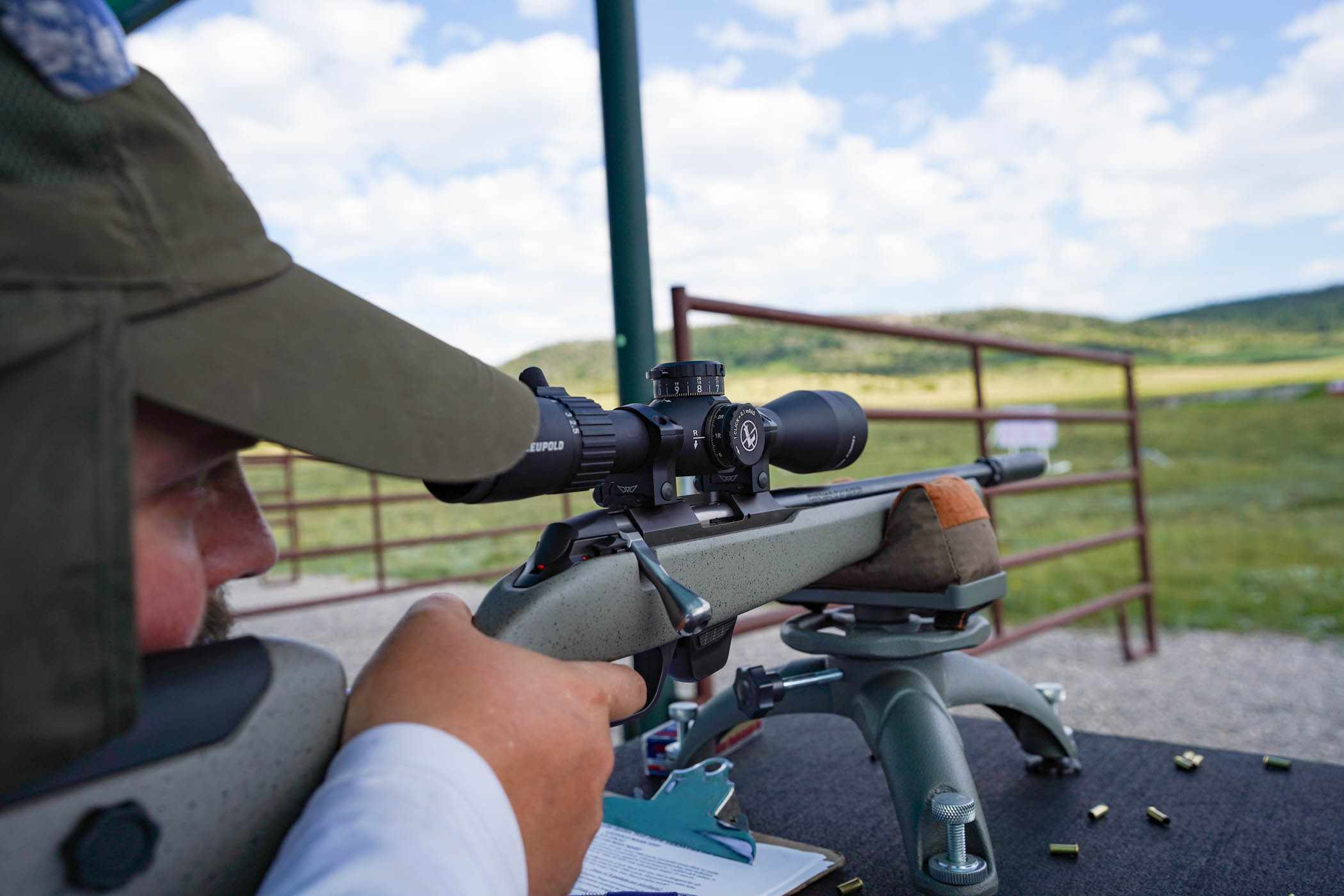
Truth is, this handy little scope in the new Mark 4HD line is all of the above. We named it the best tactical hunting scope as a testament to its ability to crossover. Our test sample came with a second-plane reticle, but the versatility is further boosted by the first-plane version of the 2.5-10×42 because of the additional precision work that reticle enables.
Still, our second-plane sample was no slouch, though we did have minor tracking issues. The Zero Lock elevation turret is big, easy to operate, and the indexing is some of the best in the field. The push-button illumination is fast, smart, and elegant, and the throw lever on the oversized zoom dial enables quick magnification changes.
The reticle, with half-MIL steps, offers four MILs of holdover and windage, and has the added benefit, rare in this category, of ranging lines at the ends of the illuminated stadia. In the second-plane configuration, the scope has to be on 10x in order to subtend correctly, but that modest magnification is perfect for most shooting and hunting purposes when precise sub-tension is required.
Testers thought the scope was overpriced compared to its peers, but the Mark 4HD offers a ton of utility in a tough, nimble package.
Best Under $1,000: Zeiss Conquest V4 3-12×44
Pros
- Brass ballistic stop
- Useful 4x zoom range
- Premium glass and coatings
- Extremely lightweight at 18.2 ounces
Cons
- Parallax fixed at 100 yards
- Duplex reticles limits precision work
Score Card
- Optical Performance: Excellent
- Mechanical Performance: Very good
- Design: Very good
- Price/Value: Good
Key Features
- 30mm tube
- Second-plane Zeiss #20 Z-Plex duplex reticle
- Exposed elevation turret tuned to .25 MOA clicks
- 70 MOA internal adjustment range
- Capped re-zeroable windage turret
- Also available in 3-12×56 version
For those of us who for years have appreciated the honest value of Zeiss’s Conquest scopes, there’s a new object of our affection. Zeiss has introduced a new configuration of the V4, in a light, simple, and bright 3-12×44 that is built for hunters who want a fast, uncluttered scope but who intend to dial longish shots.
The new Conquest V4 doesn’t have an independent parallax knob — parallax is fixed at 100 yards — and neither does it have illumination. It has a simple Z-Plex reticle with no elevation or windage holds. The scope’s lone adjustment, besides its velvety power-changing ring, is an exposed elevation turret that turns with positivity.
The idea is that a hunter, in the moment of engagement, doesn’t need to be distracted by choices. Do I hold on reticle references? Or do I dial to distance? Do I focus my target? What magnification do my reticle subtensions require? All those decision — and indecision — points are introduced into the moment by scopes that have the distracting number of amenities that brands think hunters want. With its V4, Zeiss is making a bet that a certain hunter wants less, not more.
The 3-12-power scope is suited to any number of hunting situations, and its extremely light 18.2-ounce heft makes it a good choice for a mountain rifle. Given that its elevation turret is designed to be dialed, Zeiss has added its solid brass Ballistic Stop, giving shooters a very useful return-to-zero feature. Turret indexing is bold and clear, further enhancing its dial-ability. Testers had mixed opinions of the exposed turret; some wanted the elevation turret capped to avoid inadvertent turning in the field. Others felt it’s best uncapped to facilitate fast dialing. The Ballistic Stop is an important feature so that users can easily confirm their zero on the exposed turret.
The glass and coatings are excellent, controls move smoothly and surely, and the lack of superfluous knobs gives the Zeiss a streamlined, elegant style. At just under $850, the Japan-sourced Conquest is a good value in a very serviceable hunting scope.
Best for Whitetails: Vortex Viper HD 2-10×42
Pros
- Simple, set-it-and-forget-it operation
- Reticle has useful bullet-drop references
- Smart push-button illumination
- Easily re-zeroable turrets
- Compact: 12.1 inches long and 19.9 ounces
Cons
- Could use a throw lever
- Reticle isn’t suited for precision work
Score Card
- Optical Performance: Very good
- Mechanical Performance: Very good
- Design: Good
- Price/Value: Good
Key Features
- 30mm tube
- Second-plane Dead-Hold BDC
- Capped turrets tuned to .25 MOA
- 135 MOA total elevation adjustment
- 100-yard fixed parallax
- Red center-dot illumination
With very few exposed controls and a bombproof build, this little Vortex would be at home on a mountain rifle, or a backcountry horseback hunt that requires shucking your gun in and out of a saddle scabbard. But it’s also just about the perfect mid-distance whitetail scope, with a fast and precise-enough reticle, and an excellent illumination for both daylight and last-light visibility.
The heart of the scope is Vortex’s excellent Dead-Hold BDC reticle with a .13-MOA center dot and three elevation hashes that start 1.5 MOA below the crosshair and then are spaced 3 MOA apart. The ballistician in me notes that they don’t really conform to the parabola of a bullet, which drops geometrically, not arithmetically. But users can tune the drops to their specific load using Vortex’s Long Range Ballistics Calculator, which helps expand the utility of the reticle. The reticle has 8 MOA of windage holds, at 2 MOA spaces, on either side of the crosshair.
The capped turrets are simple and useful, in keeping with the reticle, and the elevation turret enables an astonishing 135 MOA of travel. The spring-loaded turret dial is easy to re-zero in the field, though we’d like to see more visible turret indexing.
While the Viper HD doesn’t have an external parallax control — parallax is fixed at 100 yards — we only struggled with target acquisition inside 25 yards, leading some testers to note this isn’t an ideal rimfire scope. Beyond about 600 yards we again struggled with focus, as target edges didn’t seem especially sharp. But in the middle distances, the image is clear and bright, and reticle visibility is excellent.
Visibility is further enhanced with Vortex’s very good push-button illumination that lights up the center dot. We subtracted points for the dot’s significant flaring, especially at high intensities.
Testers were mixed on the price. At about $600 real-world street price, half the team thought it was priced right for its wide capabilities. The other half thought it was overpriced, considering all the amenities it doesn’t have. That shows you that, even more than ergonomics and design, price/value is a subjective assessment.
The use cases for this scope are infinite. It’s a decent AR carbine scope. It would be at home on an expedition rifle. But we reckoned that, given its versatility, its simple operation, and its mid-range talents, that it’s the best whitetail scope in our test, with plenty of talents for work well beyond deer country.
Best Value: Bushnell R5 4-12×40
Pros
- 4x magnification range
- Versatile hunting reticle with elevation and wind holds
- Excellent illumination with off settings between intensity steps
- Reticle references informed by Bushnell Ballistic App
Cons
- Poor turret/reticle tracking
- Turrets tighten noticeably as they bottom out
Score Card
- Optical Performance: Good
- Mechanical Performance: Very good
- Design: Good
- Price/Value: Good
Key Features
- 30mm tube
- Second-plane DOA-LRH800 illuminated reticle
- Capped, re-zeroable turrets tuned to .25 MOA clicks
- 60 MOA windage/elevation adjustment range
- 10 yards to infinity side parallax control
- 6-step red center-dot illumination
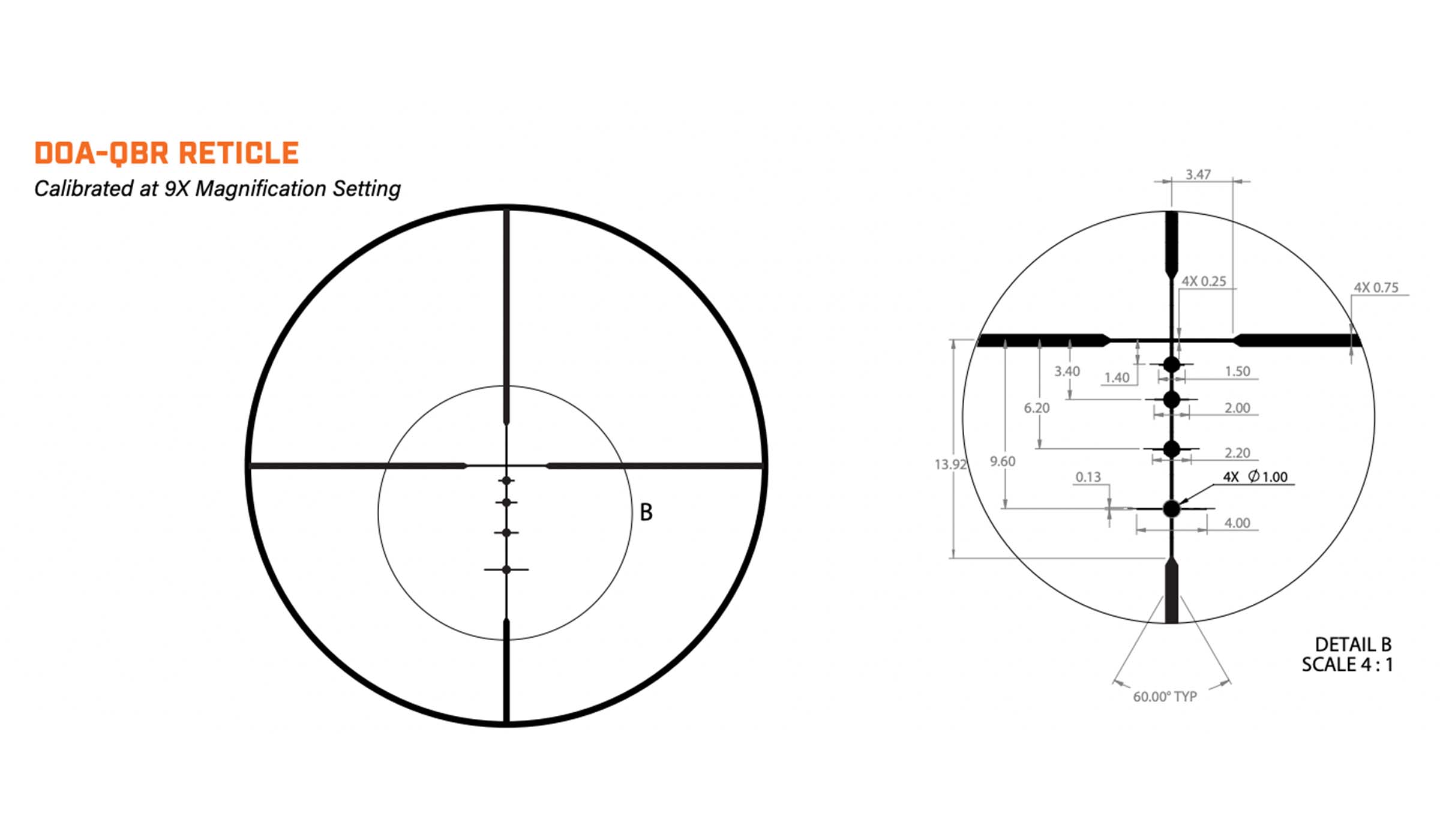
Bushnell has packed a ton of features into its new R5 line. The 4-12×40 in our test has a very good center-dot red LED illumination, and the side parallax focuses targets as close as 10 yards, making this a good air gun or rimfire scope. The second-plane reticle has decent references out to 800 yards. And the short (11.5-inch) scope nicely fits AR-pattern rifles or youth guns.
The accessible price (MSRP is $239 but you can probably find this for under $200) makes it a smart choice for a wide variety of hunting and shooting platforms, especially for budget gunners.
But there’s a cost to all those amenities in a budget scope, and users will pay it in creaky controls. We noticed that the zoom dial turns easily at lower magnifications, but then tightens toward higher powers. Same with the turrets; they turn easily and sharply in the middle of their adjustment range, but as they near the higher and lower ends of their travel, they start to stick. That’s a sign of cheap erector components, and we worry that users who really force the turrets could end up breaking them.
The Bushnell’s glass was better than we expected; it posted a very good resolution score and the 40mm scope did okay in low-light evaluations.
The DOA reticle is decent, offering MOA-based holds out to 800 yards and windage holds in both 5 and 10 mph right-angle winds. But the references are very fine, and some testers noted that they disappear against cluttered backgrounds.
Still, for a hunter who wants a scope with lots of moving parts and amenities, the R5 is priced right, and Bushnell’s lifetime warranty is a good backstop in case any of those moving parts stop moving. Given its abundant hunting chops for a very fair price, we awarded the R5 with our great buy award for the hunting-scope category.
Best Bargain: Monstrum Guardian 3-9×40
Pros
- Lots of attributes for a price-point scope
- Re-zeroable turrets
- Useful throw lever
- At $50, a screaming bargain
- Ships with shoot-through rings and flip-up lens caps
Cons
- Poor turret indexing
- Some lens fogging
- Squinty glass
Score Card
- Optical Performance: Fair
- Mechanical Performance: Fair
- Design: Fair
- Price/Value: Good
Key Features
- 1-inch tube
- Second-plane “MOA-Dot” reticle
- Red and green full-reticle illumination
- Capped turrets tuned to .25 MOA clicks
- Objective-bell parallax control, 25 yards to infinity
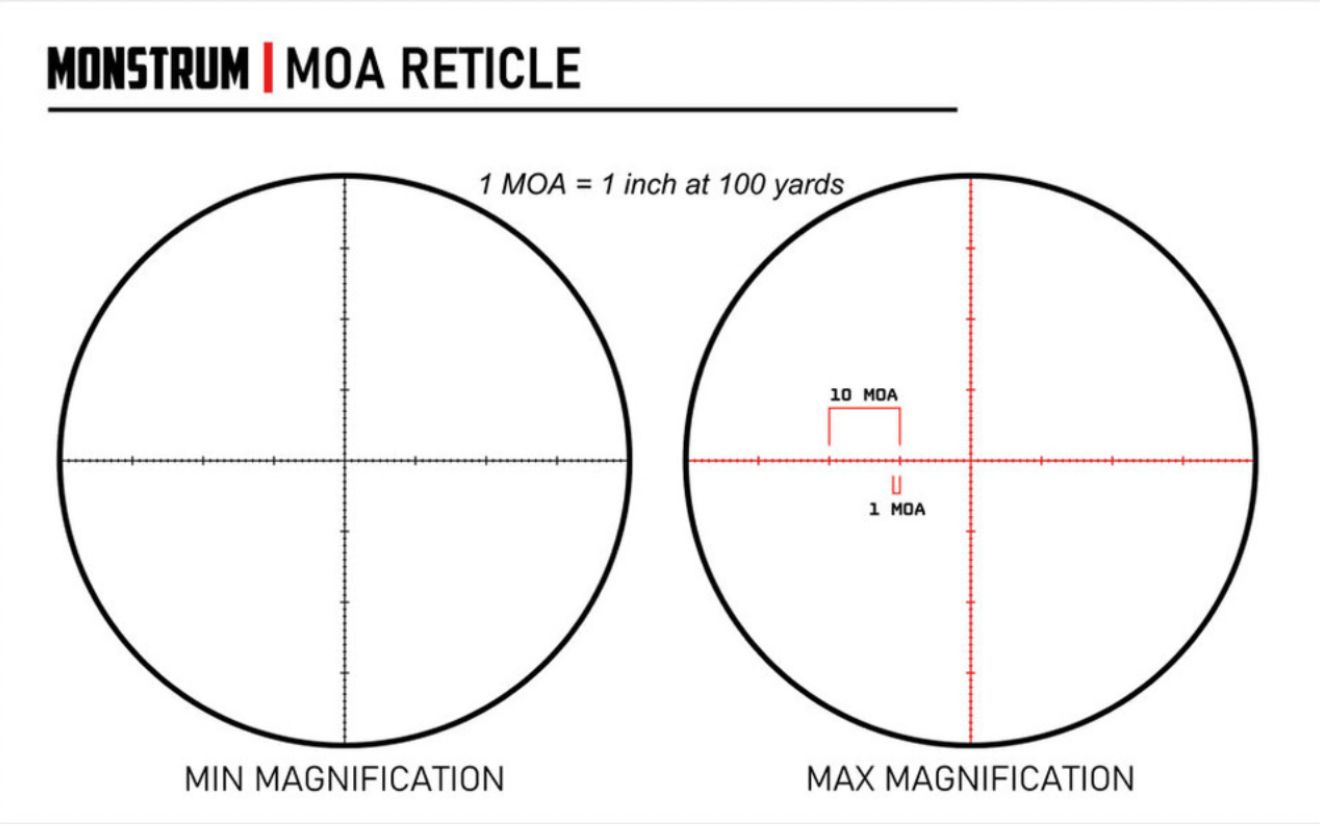
How on earth can a manufacturer bring to market a serviceable rifle scope for $50? And include a set of rings with the optic? That’s the question we’ve been asking for a couple of years, as we’ve seen the brand Monstrum selling boatloads of scopes through Amazon’s online retail store. So we invited Monstrum to our test, partly to prove to ourselves that their cheap optics aren’t actually a bargain.
So color us surprised to find that their 3-9×40 Guardian isn’t that bad. Okay, it flunked the low-light test and testers reported headaches and squints after a session behind the scope, but on matters that matter for a rifle scope, the Monstrum fared decently. Its turrets tracked perfectly with its reticle and its illumination fired up the reticle in both greens and reds. Its objective-bell parallax is clunky, but focused targets from about 35 yards to way out there.
There are some significant durability issues with this scope. Its internal lenses fogged after a freeze-thaw test, and we noticed an unsettling vibration in the erector system, like the buzz of a mouth harp, if we tapped the scope. The reticle, which Monstrum calls an MOA-Dot, is useless for anything but crosshair aiming, the “dots” looking as lumpy and indistinct as ants on a log.
But, as testers kept saying, “What do you expect for a $50 scope?” Truth is, we expected a lot less. With its lifetime warranty, the Monstrum represents a pretty appealing entry-level scope for a rimfire or air gun.
Best Straight-Wall: Hawke Vantage IR Straight-Wall Marksman 3-9×40
Pros
- Reticle has easy-to-see distance references
- Good mounting dimensions
- Handy illumination
- At about $220, a fair price
Cons
- Turrets are small and indistinct
- Turrets aren’t re-zeroable
- Turrets aren’t properly indexed
Score Card
- Optical Performance: Good
- Mechanical Performance: Very good
- Design: Good
- Price/Value: Very good
Key Features
- 1-inch tube
- Second-plane Straight-Wall Marksman BDC MOA-based reticle
- Capped turrets tuned to .25 MOA values
- 100 MOA total windage/elevation adjustment range
- 10-step red/green illumination
- Optimized for 450 Bushmaster, .45/70 Gov’t, 350 Legend, 400 Legend
- Parallax set at 100 yards
This scope absolutely ruled our four-scope straight-wall cartridge shoot-off, thanks to a clear and useful reticle that literally gives shooters specific hold-over directions. You want to zero at 100 yards? The reticle has a 100-yard reference, with the number etched on the reticle. There are other numeric etching at 150, 200, 250, and 300 yards. I know what you’re saying: all those numbers probably clutter the view.
You’re not wrong; the references are a little busy. But our testers found them to be fast, precise, and idiot-proof.
“I was skeptical about lobbing a 300-grain bullet out at 300 yards, but I just held where the scope told me and rang steel on my first shot,” noted tester Dale Manning. “It’s precise, but it’s also really fast in real-world field conditions.”
The very specific references that make this the best straight-wall cartridge scope in our test limit its wider utility. Those etched bullet drops aren’t going to help a rimfire shooter or a hunter who’s using a .30/06 or 6.5 Creedmoor. And testers hated the Hawke’s turrets, which are small and hard to turn and lack indexing.
But if you’re in the market for a scope that will lob bullets surprisingly precisely, from both 350 and 400 Legends, 360 Buckhammer, 450 Bushmaster, and .45/70 Gov’t, this is absolutely the scope for you.
Best Crossover Scope: Vortex Razor HD LHT 4.5-22×50

Pros
- Ability to focus as close as 25 yards makes this a decent rimfire scope
- XLR-2 MOA-based reticle is useful without being cluttered
- Push-button illumination is smart and both bright and subdued
Cons
- The elevation turret turns a little too easily
- Like to see a MRAD version of this reticle
Key Features
- Magnification: 4.5 to 22 power
- Field of view at 100 yards: 23.5 to 4.7 feet
- Adjustments: .25 MOA
- Weight: 21.7 ounces
- First-plane precision reticle
- Locking exposed elevation turret, capped windage turret
- Push-button illumination control
- 25-yard-to-infinity parallax
The Razor HD line has Vortex’s best glass and controls, but the LHT (it stands for Light Hunter Tactical) brings a versatile first-plane reticle to the game. The MOA-based reticle has abundant elevation and windage references for shooters who like to hold for long shots. For those who prefer to dial turrets for their aiming solution, the locking elevation dial is nicely indexed.
Vortex has done a nice job of offering a hunting scope that will feel like a precision tactical scope for long-distance target shooters, and like a precision target scope for long-range hunters. It’s the ultimate crossover scope, with a first-plane reticle tuned to MOA references, a low-profile locking elevation turret that’s easy to dial, along with a capped windage turret, and a rock-solid turret zero stop. By combining features from hunting and long-range precision shooting, the Razor HD LHT is precise without being ponderously heavy and big.
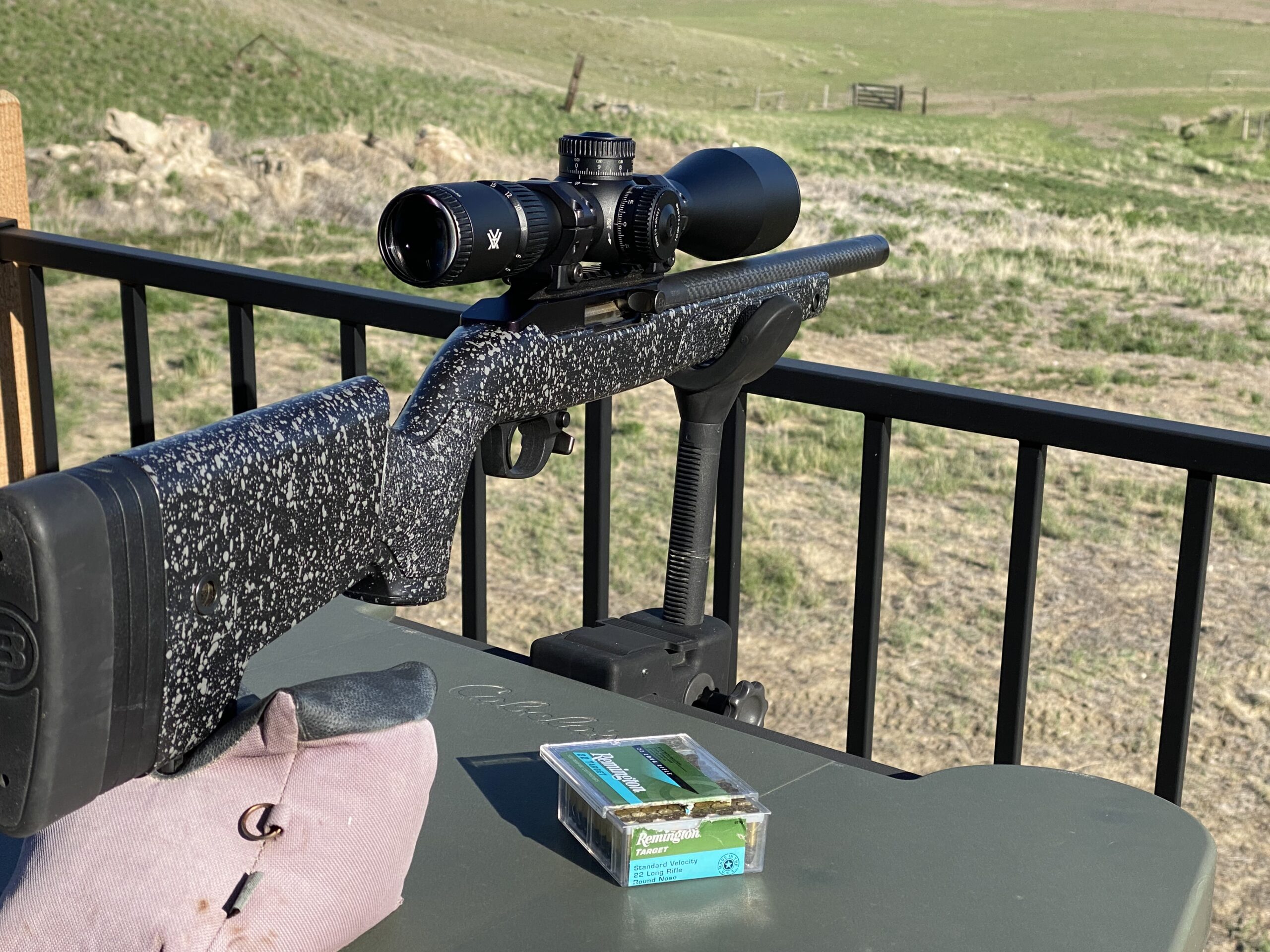
At 21.7 ounces, the 30mm scope is not a featherweight, but would be right at home on a lightweight hunting rifle. And it keeps its trim figure by combining the illumination module inside the parallax dial. Inside, the Razor HD LHT features 75 MOA of total elevation adjustment and 45 MOA of windage adjustment. The glass is bright, coatings make the image pop, and it has great durability along with Vortex’s legendary lifetime transferrable warranty.
Read our full Razor HD LHT review to learn more.
Best Compact Rifle Scope: Maven CRS.2 4-16×44
Pros
- Extremely lightweight
- Simple controls boost durability score
- Bright glass
- 1-inch tube
Cons
- Lack of reticle references may frustrate precision shooters
- Capped turrets could use more tactile click values
Key Features
- Magnification: 6 to 16 power
- Field of view at 100 yards: 25.6 to 6.4 feet
- Adjustments: .25 MOA
- Weight: 16.93 oz
- Second-plane duplex reticle with 3 elevation references
- 1-inch tube
While many brands are moving to specialist rifle scopes, specifically configured for long-distance steel targets or for AR-mounted close-quarters target engagement, Maven has introduced a useful throwback: a versatile hunting scope. The magnification range and 44mm objective make the CRS.2 a great fit for Western hunters or Midwestern whitetail hunters who might have to make longish shots.
If second-plane duplex SHR (Simplified Holdover Reticle) isn’t designed for long-distance precision work, its design enables both quick shooting and mid-range holdover shooting, by utilizing its three elevation references. With some work, a shooter can match those holdover hashes to the specific ballistic drop of their load, and then determine how much holdover to allow at specific magnifications.
While the turrets are nothing fancy, the glass and tight controls of the Maven are worth considering, along with the very accessible price from this direct-to-consumer brand.
Best Long-Range Hunting Scope: Tract TORIC UltraHD 2.5-15×44
Pros
- Turrets have very positive, tactile clicks
- Handsome graphite finish
- 10-to-infinity parallax focus
- Excellent SCHOTT high-definition glass
Cons
- Oversized elevation turret can get hung in scabbards
- Finish shows mars and scratches
Key Features
- Magnification: 2.5 to 15 power
- Field of view at 100 yards: 41.7 to 7.1
- Adjustments: .1 MRAD
- Weight: 28.3
- Available in MOA or MRAD first-plane reticle
- 30mm tube
- Oversized locking elevation turret
This pleasing scope is squarely aimed at hunters who expect to take long shots. The scope’s configuration enables low mounting on rifles and the magnification range is perfect for just about any Western hunting scenario. But the aiming system—from the oversized exposed elevation turret to the first-plane reticle that’s available in either MRAD or MOA configurations—can be used with equal success by hunters who want to hold for an aiming solution or who prefer to dial. The windage turret is smartly capped; the elevation turret has bold indexing and Tract’s Multi Rotation Zero Stop.
My test sample came with the MOA-based Hunting Reticle—it’s also available in the FFP MRAD version—that features .25MOA turret click values and 1 MOA hash marks with larger 5 MOA marks for quick holdover and wiing holdoff. Though the scope is built on a 30mm tube, it features a whopping 100 MOA (30 MRAD) of total elevation adjustment. For close-in work, the scopes have a parallax focus that zooms in to just 10 yards, making this a great choice for those entering the fast-growing .22 precision target competition.
Read Next: Best Rifle Scopes Under $500, Tested and Reviewed
Things To Consider Before Buying a Rifle Scope
The first is cost. Quality rifle scopes can cost more than even the best rifles. On the other hand, you can find good-quality scopes for under $400. Your price range and what type of scope performance you need are linked. The quality of glass, the repeatability of the turrets, magnification dial, build quality and other moving parts all shift price. If you’ll be shooting inside 200 yards, and never touch the turrets, you don’t need a $3,000 scope. But, if you’re dialing to shoot 1,300 yards and need all the low light performance money can buy, then you do need that $3,000 scope.
The heart of any rifle scope is its reticle, or the geometry of the lines in the guts of the optic that help you place your shot. The first decision is: First focal plane or second focal plane? First-plane reticles deliver the same subtensions, or aiming points, regardless of magnification, but some hunters don’t like them because the reticle gets bigger as magnification increases, potentially obscuring small, distant targets. On the other hand, second-plane reticles stay the same size regardless of magnification, which means that those subtensions change depending on the magnification. So you should consider how you’ll be using your scope. Hunters generally like second-plane reticles while precision shooters like first-plane reticles.
Lastly, consider the warranty. Rifle scopes have a lot of moving parts, between the turrets, the parallax and illumination controls, and the variable magnification dial. Plus, they get pounded with the punishment of shooting and other abuses of the field. You’ll want to make sure your purchase is fully covered with a quality warranty. Luckily, most optics these days have fully transferable lifetime warranties, which means you’re protected whether you are the original purchaser or you got the scope secondhand.
FAQs
I get asked all the time which brand of rifle scope is better than the next, and it’s often framed as whether Leupold is better than Vortex, largely because those are among the highest-profile optics brands. The answer is, it depends. It depends on which particular product you’re comparing. In general, Leupold’s VX-3HD line has better glass, more precise controls, and more durability than Vortex’s lower-end scopes, in the Crossfire II, Diamondback, and Strike Eagle lines. But Vortex’s higher-end scopes, those in the Razor HD line, deliver performance every bit as good or even better than Leupold’s VX-3 line. On the other hand, Leupold’s upper-end product lines—the Mark 5HD, Mark 6, and Mark 8—are among the best rifle scopes on the market, with prices to match.
Is there a best rifle scope for under $100? Not really. That’s because rifle scopes have to do one thing very well, and that is deliver a bullet with repeatable precision where you want it. In order to do that, you need not only decent glass in order to see your target, but you need a scope to make tiny adjustments and then stay put under the punishing recoil of a gun.
It’s hard to achieve all those goals with an optical instrument that costs less than $100. Some brands have managed it—the Simmons Truplex and Tasco’s World Class and Sportsman scopes are a couple that come to mind—but the best combination of durability and repeatable precision I’ve seen is Bushnell’s Banner, which retails for just under $100 and should deliver years of adequate performance. One thing to consider for a budget-priced optic: make sure it comes with a good, reliable warranty.
Rifle scopes have several different lens elements, and often brands use different qualities of glass for each lens. But the most important of these lenses in terms of image quality is the biggest one. That’s the objective lens, or the big lens that’s closest to your target. You’ll see qualities of glass described as ED (extra-low dispersion) or HD (high-definition), and generally these specialized glass will be clearer than generic glass. But equal to the quality of glass in a scope is the quality of the coatings. These are the microscopic films that help reduce glare, boost contrast and color fidelity, and make images and the reticle “pop” when you look through the scope. It’s almost always worth paying a little more to get proprietary coatings and a better grade of objective-lens glass.
Are hunting rifle scopes used in the military? Not generally. Because military optics have to take more punishment than hunting scopes do, they are generally overbuilt. Some rifle scopes that you might see at your local sporting goods store are found on military rifles—Leupold’s Mark 5HD is a good example. It’s been selected for the U.S. Army’s Precision Sniper Rifle program—but generally, the military specifications are so rigorous in terms of holding up to the punishment of war that sports-optics brands don’t compete for contracts. That said, Steiner’s M7Xi is a favorite of military snipers, and Nightforce’s precision rifle scopes are used by Marine Corps snipers.
Generally, Burris scopes have good quality and durability. That said, the lower-priced product lines tend to have lesser-quality glass and a less robust build than higher-priced product lines. That stands to reason. Also, the more electronics inside a scope, the less durable they are, simply because recoil, moisture, and field abuse are hard on electronics. That’s why Burris’s celebrated Eliminator line of rangefinding rifle scopes tends to have weaker warranties than non-electronic scopes. But Burris’s XTR Pro series of tactical scopes are among the best and most durable precision scopes on the market.
You can spend anywhere from $100 to $4,000 on a rifle scope. So, what differentiates the widely divergent prices? Everything from the quality of glass in the scope to the precision of the erector system and turret controls. The most precise optical instruments have such intricate moving parts that they require extra manufacturing and quality-control steps, adding to the cost. And the best grades of German and Japanese glass can cost three to four times the lower grades of Chinese and Malaysian glass on the market. Once you start adding features like Bluetooth connectivity, an illuminated reticle, and rangefinding capabilities to a scope, the price rockets upward. But all those features make the scopes even more precise and reliable tools for placing bullets at great distance, and isn’t that what you want a rifle scope to do?
Final Thoughts on Rifle Scopes
Rifle scopes have such variability (of magnification, size, reticle type, and turret design) that picking a purpose-built optic for multiple uses is fraught with problems. On the other hand, expecting a do-everything versatile scope to perform the specific tasks of mile-long steel-plate shooting or low-light, close-quarters combat shooting has just as many problems.
The idea of this roundup is to introduce readers to a wide variety of scope types, and discuss their attributes for specific shooting tasks as well as their ability to solve a number of diverse shooting challenges. Ultimately, you should pick a type of scope—whether a long-range precision scope, a low-power variable optic, or maybe an all-around hunting scope—that suits your needs and then compare models within that niche.

